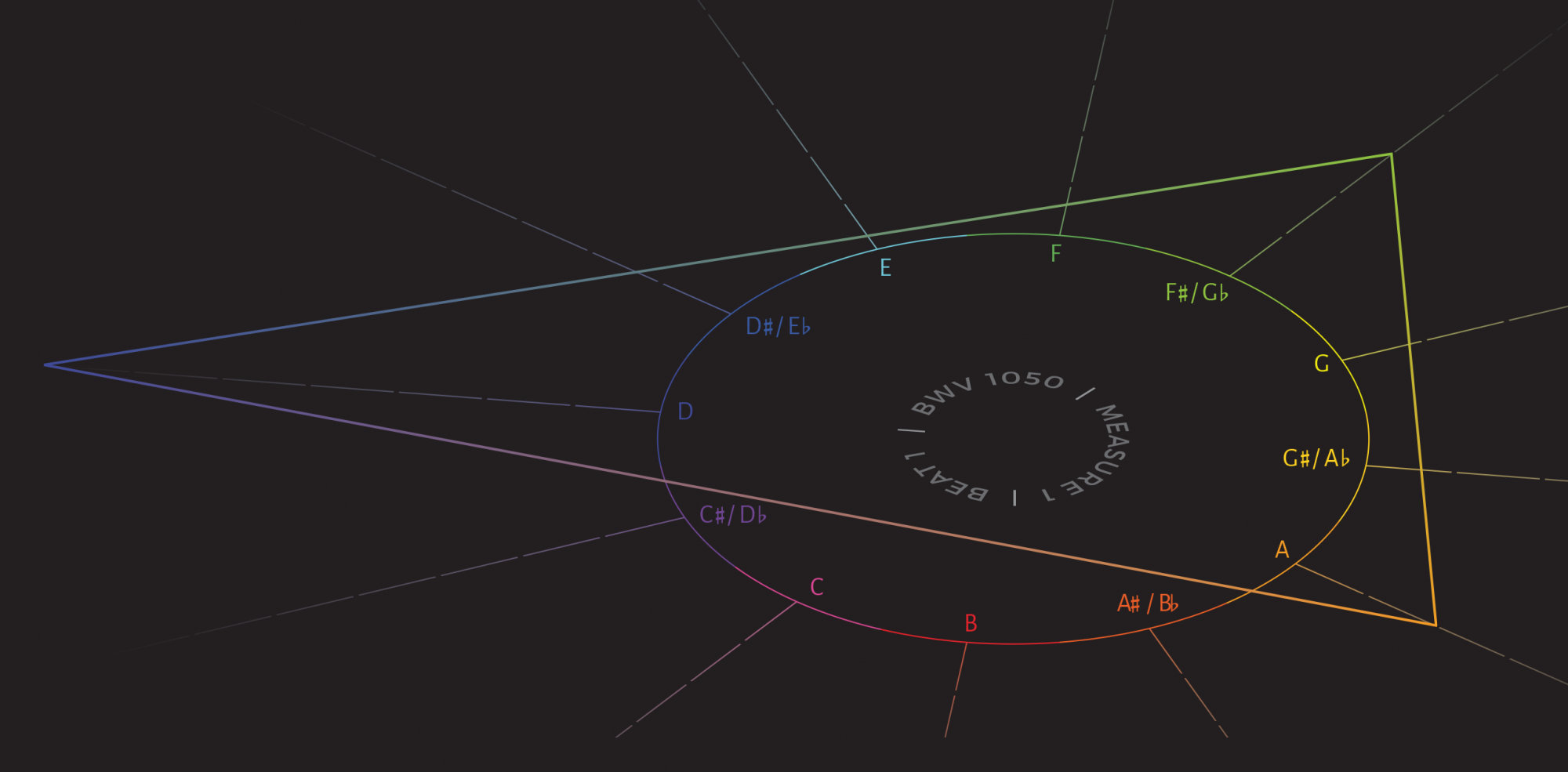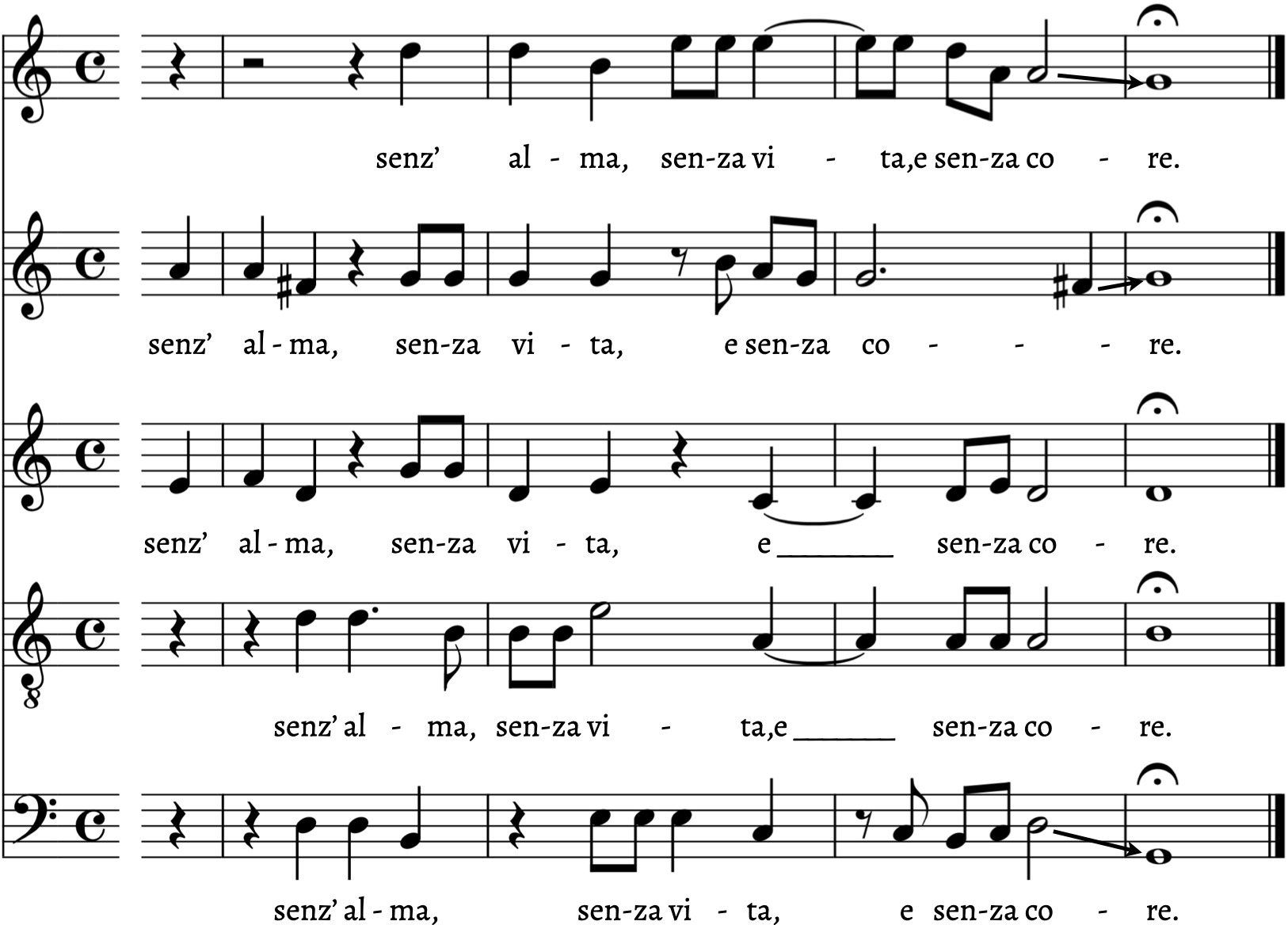Derek R. Strykowski
Abstract
Although two of the madrigals from his Third Book of 1615 end in lovelorn questions, Sigismondo d’India furnishes one of them with a far stronger final cadence than the other. To understand why, this corpus study investigates the expressive meaning of cadences in a quantitative analysis of the 85 madrigals that d’India published within his first five books (1606–16). Three determinants of cadential strength—cadence type, fullness, and modal degree of resolution—test the hypothesis that the cadences which d’India employs at the close of interrogative sentences will tend to be weaker than those he employs at the close of other sentences. The results are consistent with the argument that d’India sought to account for the sense and intonation of an interrogative sentence when setting it to music, yet also suggest that such concerns sometimes conflicted with his obligation to present a coherent musical structure.
Keywords and phrases: Sigismondo d’India; cadence; madrigal; syntax; intonation
1. Introduction
All but one of the five-part madrigals that Sigismondo d’India published in his Third Book of 1615 conclude with the same familiar cadence: a resolution to the final pitch via stepwise contrary motion, accompanied by the leap of a rising fourth or a falling fifth to the same pitch in the bass. The remaining voices fill out the harmony. But in “O fugace, o superba,” the eighth work in the set, the composer eschews what some scholars now call a full authentic cadence to provide a radically different ending to the music.
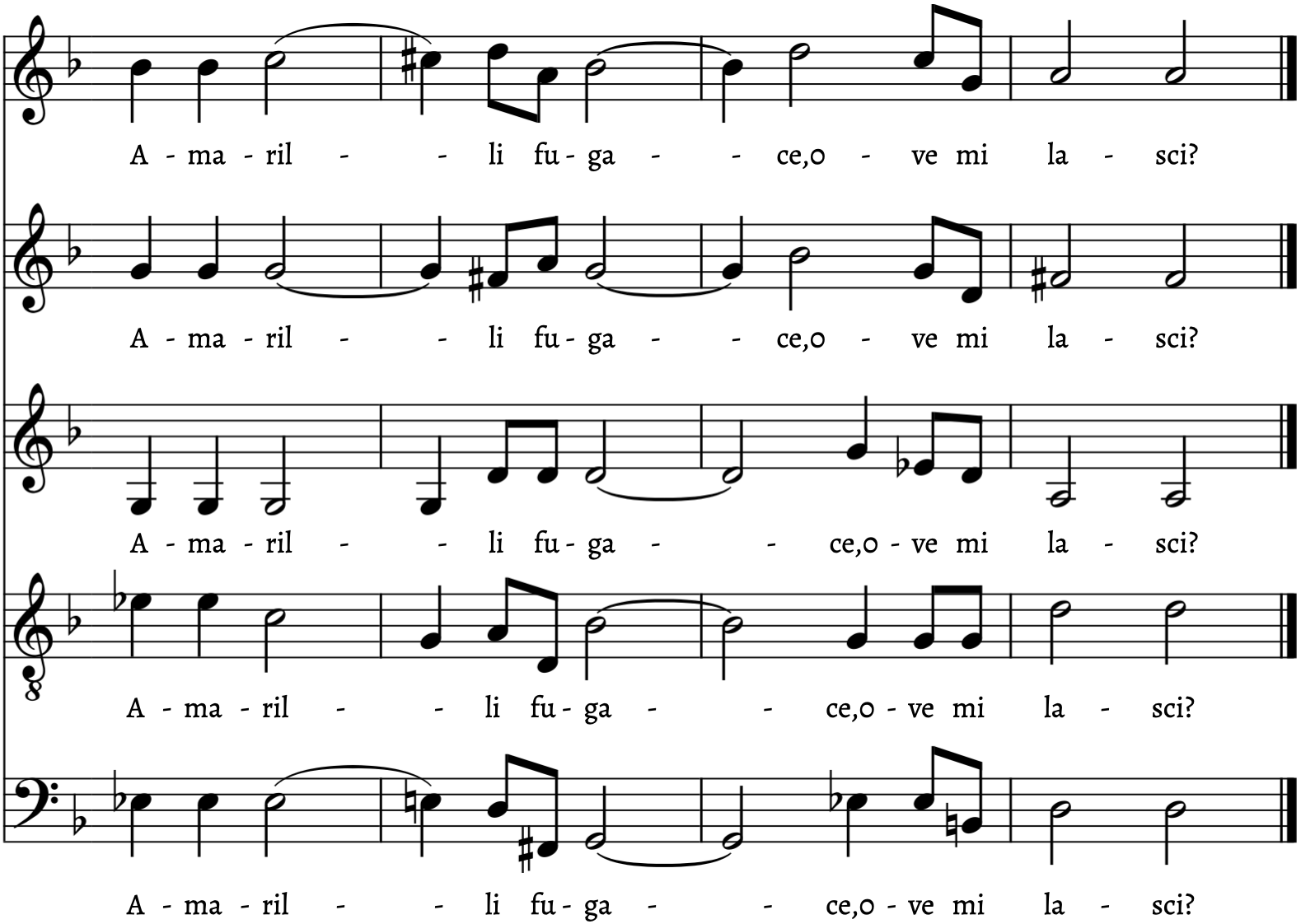
Example 1. An unusual final cadence concludes the phrase “Amarilli fugace, ove mi lasci?” (Where dost thou leave me, fleeing thus from me?) in mm. 54–57 of d’India’s “O fugace, o superba” ([1615] 1998, 68).
As the madrigal reaches its final harmony (Example 1), the expected contrary motion is nowhere to be found.1 2 The leap in the bass spans not a perfect fourth or fifth but instead a minor third. The listener may consequently feel a sense of interruption, as if the singers have discontinued the music before truly reaching the end of the phrase. That d’India chooses not to provide the typical longae note values for the final harmony, creating an effect that the work’s modern editors (d’India [1615] 1998, 181) have deemed “abrupt,” serves only to underscore the listener’s impression that the singers are being cut short.
While some contemporary analysts may hear the final harmony (D major) as “dominant” to the penultimate harmony (G major), the length of the “tonic” harmony is too short—and the reasoning too anachronistic—for the progression to be considered a half cadence. Nor does the expected half-step descent to F$$\sharp$$ occur within a single voice part, as would better suit the contrapuntal norms of the style. There is nevertheless a cadence of sorts to be found at the end of the phrase. Consider the falling half step from E$$\flat$$ to D heard in the third voice (m. 56), and the broader motion between those same pitches that the bass provides in mm. 56–57. Both evoke the downward stepwise resolution of a Phrygian cadence, even as the highest voice fails to produce the expected contrary motion. Add to this the momentary harmonic diversion that immediately precedes the final harmony, and the cadence is almost unrecognizable.
For d’India to have concluded the madrigal with such an extraordinary gesture must mean something. Stefano La Via (2013, 51–52) has called attention to the range of extramusical connotations that Vincenzo Galilei ascribes to four of the most common cadence types found in the Italian madrigal: those that La Via has identified as Phrygian, half, perfect, and authentic.3 He has demonstrated that Galilei, along with many composers of the seconda pratica, understood the various cadence types to provide not only markers of musical syntax but also a means of semantic expression.4 Predictably, Galilei associates the contrapuntal strength of the authentic cadence type with traits such as pleasure and virility, the weaker types with traits such as softness, effeminacy, and unease (inquieta). A composer must decide not only the basic cadence type but also other variables such as rhythmic (im)perfection and textural fullness. Naturally, some of the combinations that result will sound more conclusive than others.
La Via (2013, 49) concludes that “cadences have always played a role that is not only syntactic or superficially structural but also semantic, forming part of the musical expression of the text,” especially in the Italian madrigal. A glance at the text of “O fugace, o superba” (d’India [1615] 1998, 62) suggests almost immediately how its message may have influenced d’India’s compositional treatment of the final cadence:
O fugace, o superba,
O più che vento rapida e lieve,
O più che marmo dura:
A le mie voci ed all’incendio mio,
Via più fredda che neve,
Amarilli crudel, spietata e ria,
Ove fuggi? O chi fuggi? O perché fuggi?
Deh! Ferma, ohimè, lo sbigottito piede,
Amarilli! Deh! Torna e ferma alquanto!
Amarilli fugace, ove mi lasci?
O swift of foot, in proud disdain,
Faster and lighter than the winds that blow,
Unyielding more than marble is
To my entreaties and my burning love,
Colder by far than any snow,
O cruel Amaryllis, merciless,
Where art thou fleeing, and from whom, and why?
Ah, stay, alas! thy terror-driven feet;
Turn back, o Amaryllis, bide a while!
Where dost thou leave me, fleeing thus from me?
The lyrics closely resemble a rendition of the story of Daphne and Apollo that Giambattista Marino (1627, 37–38) would publish five years later in his celebrated Egloghe boscherecce of 1620. The lines are all but identical except for those that make reference to Daphne (as “Dafne” or the “ninfa”) rather than to Amaryllis. In d’India’s setting, the unusual final cadence would appear to evoke the state of confusion—or sullen frustration—in which the protagonist finds himself as Amaryllis flees his advances. The cadence is timed to coincide with the delivery of one final, desperate question: “ove mi lasci?” (where dost thou leave me?), a question to which the protagonist receives no reply. The text, like the music, ends without clear resolution.
1.1 The Patterns of Composition
Yet even as “O fugace” remains the only madrigal in the Third Book to conclude without a full authentic cadence, it is one of two madrigals in the book to end with a question. The text of “Dove, ah dove t’en vai?” (d’India [1615] 1998, 9) ends with a plea born of similar romantic frustration: “Qual ben hor più m’avanza,/Se fuggi tu, dolcissima speranza?” (What good to me is left/If, sweetest hope, of you I am bereft?). Despite its poetic resemblance to “O fugace,” d’India concludes the madrigal with an authentic cadence (Example 2) as strong and as full as any of the other final cadences in the collection.
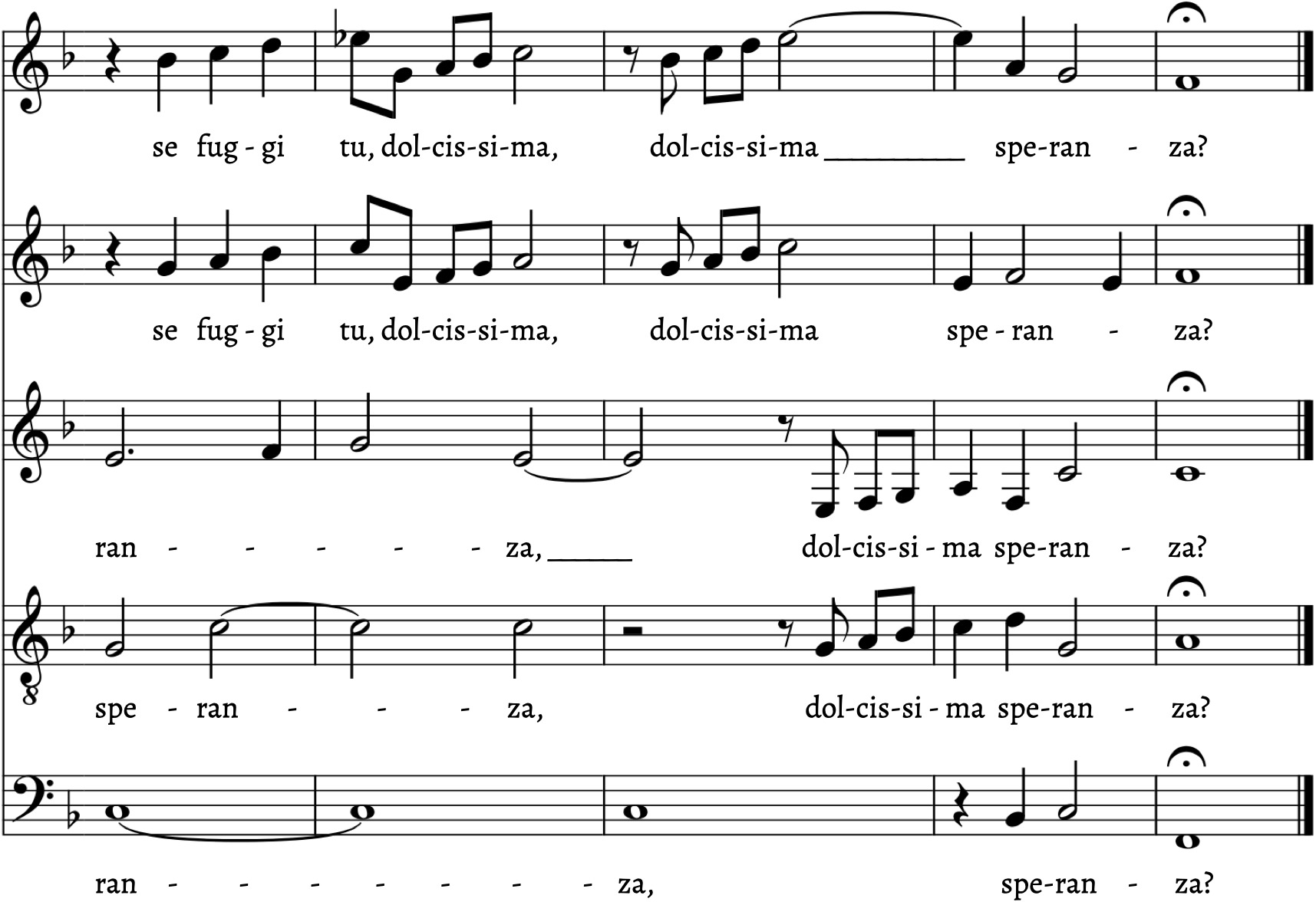
When examined side by side, the pair of examples presented thus far would seem to belie a general rule. Seeing as such lovelorn questions could lead d’India to end his madrigals with either ordinary or idiosyncratic cadences, which was he more likely to employ? To arrive at a satisfactory answer to this research question, we must therefore understand the frequency with which d’India gave special cadential treatment to interrogative sentence endings.
A wide spectrum of empirical methodologies is available for this purpose, including the familiar qualitative analysis of several well-chosen examples. Yet because we seek evidence of a real statistical tendency, a quantitative method seems most appropriate here. To be more specific, a narrowly conceived corpus study of the cadences found at sentence endings throughout d’India’s madrigals can help to illuminate the general patterns of his behavior as a composer.
Even with such a corpus study at its heart, the present research strikes a balance between the identification of broad compositional trends and the application of those trends in the analysis of specific musical examples. A familiarity with those trends can help us to make better sense of cadences such as those presented above by revealing when d’India deviates from the statistical norms of his style. The general can inform the particular, in other words, just as—collectively—the particular informs the general. The two approaches are thus interrelated, although by committing to a corpus study we must consequently forgo much of the detailed analysis that a purely qualitative study of individual works would require.
This points to the larger ramifications of the chosen method: that such quantitative research provides a welcome measure of statistical certainty when it comes to the broad trends, but can do little (we must acknowledge) to explain the many idiosyncrasies inherent to specific musical examples, even those drawn from within the corpus being studied. At the same time, the cadential behaviors observed here in madrigals of d’India readily invite comparison with those to be observed in the madrigals of other composers from the period. The works of those who flourished before and after d’India present other possible avenues of comparative research.
1.2 Hypothesis
In order to conduct a formal empirical study—“formal” in the sense that we can determine objectively whether the outcome of the study is true or false—we must begin with a clear hypothesis in hand: that the cadences which d’India employs at the close of interrogative sentences will tend to be weaker than those he employs at the close of other types of sentences. The corresponding null hypothesis (H₀) would find no observable difference in the strength of the cadences that d’India employs at interrogative sentence endings. To prove or disprove this hypothesis will not, of course, tell us why d’India chose specifically to conclude “O fugace, o superba” and “Dove, ah dove t’en vai?” as he did. But it will reveal which of the two is more anomalous, more difficult to explain within the patterns of d’India’s compositional style.
After first introducing the d’India corpus in Section 2, the study tests the above hypothesis in Section 3 by measuring three determinants of cadential weakness in turn: cadence type, fullness, and modal degree of resolution. Section 4 compares the results against both historical and contemporary theoretical arguments before exploring whether d’India treats final cadences differently than those that occur earlier in the music. Finally, Section 5 addresses the theoretical import of the study and suggests some avenues of future research.
Many readers will recall Monteverdi’s (1607) well-known declaration that in vocal music of the period, “the harmony . . . becomes not the master of the words but the servant” (l’armonia . . . di padrona diventa serva al oratione). Such a logic would suggest that the semantically unremarkable cadence which ends “Dove, ah dove t’en vai?” may, in its very normality, be the exception rather than the rule. Yet the results described below reveal that for d’India, the relationship between words and music was far more nuanced than this. All told, the study both clarifies and complicates our understanding of the composer’s text setting practices.
2. The Madrigals of Sigismondo d’India
To determine whether the hypothesis presented above has merit, we must therefore examine the cadences with which d’India accompanies all types of sentence endings (not only interrogatives) throughout the corpus of his polyphonic madrigals. Our attention will return to the individual analysis of the two madrigals introduced earlier once the statistical results of the corpus study are in hand.
Sigismondo d’India published eight books of five-part madrigals between 1606 and 1624. Giuseppe Collisani (1998, 37) has observed that “the madrigal, precious jewel of the sixteenth-century musical treasure trove, lived at that moment in a mature and very florid phase” even as d’India began to publish his first essays in the genre. To be less charitable, the madrigal—like polyphonic music in general—was fast becoming an antique. It was, of course, not the only genre to give exercise to contemporaneous concerns about the relationship between words and music; many madrigalists active at the turn of the seventeenth century became accomplished composers of monody as well.
Indeed, d’India often receives the most acclaim for his contributions to the newer monodic styles of vocal composition. There, as throughout his works, the composer demonstrates a skillful attention to the practice of text setting—even at the expense of musical propriety. To hear d’India himself tell it, the subject was one that had fascinated him since youth. In his introduction to Le Musiche of 1609, the composer recalls:
I discovered that one could compose in an authentic manner using extraordinary intervals, passing with as many novelties as possible from one consonance to the next, in accordance with the varied meanings of the words, and that by this means the songs would have greater emotion, and greater power to move the emotions of the soul, than they would have if they had been composed all in one style with ordinary progressions. (1609, iv)
The outcome was an innovative monodic style that John J. Joyce (1981, xv–xvi) has nevertheless found to be “indebted to sixteenth-century vocal practice.” He notes in particular that d’India favored prominent speech rhythms even as he integrated them within a broader palette of melodic techniques, that he did not hesitate to employ wide leaps and chromaticisms in the service of melodic declamation, that he took similar license with the handling of harmonic progressions, and that he established a diverse collection of original vocal ornaments. These techniques came to define d’India as a monodist but also reveal the expressive priorities that characterize his work in other genres.
In tandem with his cultivation of the monodic style outlined above, d’India maintained an interest in polyphonic writing throughout his career and became one of the last great exponents of the seconda pratica madrigal as well. “In the relationship between poetic text and musical dress d’India followed the Monteverdian principle of the seconda pratica,” writes Giuseppe Collisani (1998, 39–40). Collisani observes that d’India accomplished this by ensuring that his music, as the “servant of the words,” would always agree with the content of the text, even as he eschewed—again like Monteverdi—many of the more formulaic expressive devices that by then had become text-setting clichés. More recently, scholars like Gregory J. Decker (2014–15, 208) have argued that the composer’s approach to text setting differed fundamentally from that of Monteverdi due to the formative influence of expressionist madrigal composers such as Giaches de Wert. However, the general consensus appears to be that d’India was more adept than most at blending Wert’s expressionist style with those of younger composers such as Marenzio, Gesualdo, and indeed Monteverdi (see Joyce and Watkins 2001). Such an association with Monteverdi and his second pratica begins already to imply that when it came to writing cadences, d’India may well have prioritized the text over the music.
The present study examines that claim within the five books of polyphonic madrigals that d’India published between 1606 and 1616, which together comprise the modern edition edited by John Steele and Suzanne Court. The Third Book of 1615 incorporates a basso continuo part—obligatory in its final eight concertato madrigals—in imitation of the approach taken in Monteverdi’s Fifth Book of 1605, while the other volumes are composed purely in the polyphonic tradition. D’India later published three additional books of five-part madrigals, which for various reasons do not appear in the aforementioned edition.5 The 85 madrigals that d’India published within the first five books alone nevertheless form an impressive corpus.
The edition is especially useful because Steele and Court provide not only the music of each madrigal in score, but also the poetry that d’India chose to set, printed at the beginning of the score in a form that aligns whenever possible with an authoritative modern edition of the text in question (d’India [1606] 1997, 103). The punctuation of that poetry provides a ready means to identify the interrogative sentences found therein without regard to the historically haphazard punctuation that d’India may have encountered or himself propagated while setting it to music.6 In fact, the punctuation occasionally varies between voice parts even in the modern musical edition used here. The poems are also accompanied by rhymed English translations crafted by Barbara Reynolds, although these understandably distort the syntax—and at times the meaning—of the original Italian.
2.1 Questions in Text and Speech
Punctuation is indeed the key to extending La Via’s arguments about the role of cadences, quoted earlier, to a third domain within which they can inform a listener’s understanding of the madrigal: not the structure of the music, nor the meaning of the text, but rather the structure of the text—that is, the sentence structure. This last domain comprises both syntax and prosody to the extent that a question such as “ove mi lasci?” can govern not only the sentence’s terminal punctuation mark but its intonation (among other prosodic concerns) as well.
Taking first the matter of syntax, we must acknowledge that sentences can end differently. Interrogative sentences usually end with a question mark, while declarative sentences usually end with a period. Thus are we able to distinguish in written language between the meanings of nearly identical phrases such as:
Tu me ’l nieghi?
Tu me ’l nieghi.7
In other words, interrogative sentences are often marked by a unique syntactical feature: the presence of a question mark at the end. This is not always the case, of course, particularly in texts that precede the era of standardized punctuation. Other linguistic devices are available by which to cast a sentence in the interrogative—whether in English or Italian—that do not depend on the shape of the final punctuation mark to be understood. Even so, writers in Western Europe have been making use of the question mark since long before the sixteenth century. During the Middle Ages, the punctus interrogativus was one of the four positurae with which scribes began to punctuate liturgical manuscripts (Parkes 1993, 306). There is perhaps some fortuity in the fact that these symbols appear to have originated in a performative context, to indicate the stock melodic formulae with which to conclude chanted passages of the liturgy (Parkes 1993, 36).
By the late sixteenth century, Italian humanists such as Lionardo Salviati understood the question mark to possess “the function of signaling a pause that, from the point of view of syntactic force, is equivalent to that indicated by the period, but which differs in the modality (at once logical-syntactic and intonational) that marks the sentence (interrogative rather than assertive)” (Tonani 2011). The fact that question marks share the same “syntactic force” as periods and other terminal punctuation symbols is important to keep in mind as we proceed.
The difference is often not just a matter of syntax but of prosody, as Tonani (2011) has also observed. That is to say, questions can sound different than declarative statements, too. Try speaking aloud the pair of sentences printed above. Given that such distinctions are frequently communicated in nonmusical speech through the use of appropriate stress and intonation, we must consider whether in music a sentence ending can similarly influence the character of the melody that supports it.
To be sure, questions spoken in Italian require much the same intonation as they do in English. The two basic patterns of intonation that most often accompany them are (1) a fall in pitch and (2) a fall and then a rise. Marguerite Chapallaz (1964, 309) explains that speakers of Italian rely even more on the telltale second pattern when voicing general (i.e., yes–no) questions because the language “has no special grammatical written forms corresponding to est-ce que or to the inversion of the subject in French, nor to the anomalous finites in question forms in English.” An interrogative sentence may thus have provided a composer of the Italian madrigal with the opportunity to communicate the punctuation that makes it a question through the prosody with which a speaker would intone that fact in a non-musical context.
The present corpus study undertakes one of the first empirical explorations of the extent to which composers like d’India did, in fact, avail themselves of that opportunity. At stake is the possibility that d’India may have intended the final cadence of “O fugace, o superba” to communicate not only the meaning of the speaker’s emotionally charged question but also its very identity as an interrogative phrase.
2.2 Sentences in the Corpus
The poetry is therefore an essential starting point. Taking each madrigal in turn, the researcher has manually identified and catalogued all of the complete sentences (usually three or four) that together form the dozen or so lines of the poem, whether or not they pose a question. The sentences must satisfy an operational definition that recognizes as a complete sentence any sequence of three or more words—regardless of grammar—that concludes with, but does not otherwise contain, one of the following terminal punctuation marks: a period ( . ), an exclamation mark ( ! ), or a question mark ( ? ). By their very nature, other punctuation marks such as a comma or a colon signal that the sentence has not yet reached its conclusion. There are, however, a handful of cases in which d’India concludes an entire section of music (distinguished in the modern edition by the presence of a double bar line) with a cadence that falls on one of these other marks.8 These rare instances are included in the data as if the phrases had ended with a period instead.
Most, but not all, of the sentences to be found in the poetry conclude at the end of a printed line. A few of the texts feature either enjambed or very short sentences that conclude somewhere in the middle. With rare exceptions, d’India always aligns the end of a sentence with a cadence in the music. Given that so many of the printed lines end with some form of punctuation, it hardly comes as a surprise that the composer places cadences at many line breaks as well. In accordance with the hypothesis presented above, however, note that the present study concentrates exclusively upon d’India’s treatment of the ends of complete sentences and not upon his treatment of the ends of poetic lines. For example, here is a madrigal text authored by Ottavio Rinuccini that d’India ([1615] 1998, 17) sets to music in his Third Book of 1615:
Dovrò dunque morire
Pria che di novo io miri
Voi bramata cagion de miei martiri?
Mio perduto tesoro,
Non poter dirvi pria ch’io mora, “io moro”?
O miseria inaudita!
Non poter dir a voi: “moro, mia vita!”9
Although the poem occupies seven lines of printed text, the methodology described above relies on the question marks and exclamation points found therein to isolate four complete sentences, each ending in a cadence.
The terminal punctuation marks therefore provide a straightforward way to classify the sentences that they conclude. Sentences that end with a question mark may be considered interrogative, while those that end with an exclamation mark or a period may generally be considered exclamatory or declarative.10 As such a method does not recognize the possibility of (say) an imperative sentence, these operational definitions would be inadequate were the task not simply to separate the interrogative sentences from the rest. And given the vagaries of seventeenth-century typesetting, noted earlier, the method described here is unlikely to be able to identify all of the interrogative sentences that are present in the corpus (a Type II error) because some of them—even in a modern poetic edition—may not be furnished with a question mark. But we can safely assume that any sentence which does end in a question mark is indeed an interrogative one. In other words, the possibility that the poetry consulted here would use a question mark at the end of a different type of sentence appears remote.
We may also observe that d’India did not give separate cadential treatment to short emotive interjections (e.g., “Deh!”) because their length does not readily support the contrapuntal motion necessary to form a complete cadence, even though they bear one of the terminal punctuation marks listed above. How short is too short? Conveniently, there are no two-word sentences in the corpus. For the sake of a clear operational definition, the study therefore ignores sentences that comprise only a single word while allowing those that comprise at least three words to remain in the data.
D’India sets most of the sentences found in the corpus just once, to be sung from beginning to end in the course of a single musical phrase—or, for longer sentences, a series of phrases. In such cases, the cadence naturally falls at the end of the (final) phrase. Repetitions of the text are not infrequent, however, and thus necessitate a few additional rules. Some repetitions serve merely to prolong a sentence internally, especially by passing the text between different groups of voices, while others make a more substantial return to several poetic lines repeated as a unit. To exclude the former, the study includes cadences that fall before a textual repetition only when d’India proceeds to repeat more than a single poetic line.11 One of the concertato madrigals found in Book Three also includes a printed repeat sign, which can be ignored entirely (d’India [1615] 1998, 104). Final cadences, including those that close a complete section in a multipartite madrigal, have been duly noted as well.
Following the procedures described above, an analysis of the 85 poetic texts that d’India sets to music in Books One through Five of his polyphonic madrigals shows that they contain 239 complete sentences between them. In five of his fourteen bipartite madrigals, the composer brings the first section of music to a close somewhere in the middle of a sentence.12 The inclusion of these clauses-turned-sentences, as prescribed earlier, brings the total to 244. Finally, in setting the poetry to music, d’India substantially repeats the texts of 87 sentences, which raises the total again to 331. This figure represents all of the sentences examined in the present study.
All but four of the 331 sentences identified above reach their conclusion at the same time that the music reaches a cadence. In other words, d’India almost always aligns the end of a sentence with the end of a musical phrase. Two of the exceptions appear together in “O fugace, o superba” (d’India [1615] 1998, 66) at the beginning of the line “Ove fuggi? O chi fuggi? O perché fuggi?”, which the composer sets as a single musical phrase. The third is a somewhat longer interrogative sentence that also ends in enjambment, while the fourth is a declarative sentence that does not.13 Furthermore, 104 sentences end in conjunction with the end of a final phrase: one that concludes either the entire work or (in a multipartite madrigal) a distinct section thereof.
| Interrogative | Other Types | All Types | ||
| Middle of phrase | 3 | 1 | 4 | |
| End of interior phrase | 56 | 167 | 223 | |
| End of final phrase | 6 | 98 | 104 | |
| Total | 65 | 266 | 331 |
The preceding observations are summarized in Table 1, which also reveals that 65 of the sentences (about 20 percent) can be identified as interrogative due to the presence of a question mark as the final point of punctuation. This figure includes not only the three enjambed sentences noted above but also six of the 104 sentences that conclude at the end of a section or a work. The remaining sentences, most ending with either a period or an exclamation mark, are not only declarative or exclamatory in nature but at other times imperative and perhaps even interrogative as well.
2.3 Syntax in Word and Music
Finally, the hypothesis that d’India would employ weaker cadences at interrogative sentence endings supposes that madrigal composers do, in fact, align the ends of sentences with the ends of musical phrases when setting a text. That d’India concludes only 4 of 331 sentences from the corpus in the middle of a musical phrase establishes the broad accuracy of this supposition. It is furthermore a matter on which most sixteenth-century theorists are in strong agreement:
You ought in every way to observe that which many of the ancients already observed, namely, to place such rests nowhere else but at the end of phrases or on the punctuation of the text to which the music was composed and likewise at the end of every sentence. . . . By no means should they be placed anywhere before the meaning is complete, as in the middle of a clause, for anyone who places them thus proves truly to be an ass, a blockhead, and an ignoramus. (Zarlino [1558] 1965, 212, trans. Harrán 1986, 393)
Here, Gioseffo Zarlino drives home the point that when setting a text to music, composers should refrain from ending a musical phrase in places that might spoil the natural declamation of the spoken sentence, lest the resulting confusion betray them to be any of the unfortunate creatures cited at the end of the paragraph.
Zarlino, who published his Istitutioni harmoniche in 1558, is hardly the only writer to insist that composers pay attention to the alignment of textual and musical phrasing. For example, Calvisius echoes Zarlino’s admonition in 1592 with the advice that “though a proper cadence, then, may have a place anywhere at the beginning, in the middle or at the end of a particular song . . . , it is customarily made nowhere else but at the end of the whole piece or of its sentences” (Calvisius 1592, fol. I, 3–3v, trans. Harrán 1986, 395–396). The late Don Harrán has assembled a catalog of these injunctions from an impressive number of sixteenth-century theorists in his book Word-Tone Relations in Musical Thought (1986, 391–396). He locates them in the writings of not only Zarlino (1558) but also predecessors such as Giovanni Maria Lanfranco (1533) and Giovanni del Lago (1540) through later theorists such as Gaspar Stoquerus (ca. 1570) and the aforementioned Seth Calvisius (1592). Gary Towne (1990, 265–266) has since distilled the entire collection into a general maxim—namely, that “composers should plan cadences and rests so musical and textual phrases coincide.”14
When stated in so few words, the advice begins to feel rather obvious. And, as noted in the introduction, Monteverdi’s insistence that the music is the servant of the words helps to underscore the importance that the principles of text setting hold for composers as well. Writing in 1607, Monteverdi is at least a generation younger than any of the theorists cited above, but for genres like the Italian madrigal, his seconda pratica may represent less a break with sixteenth-century humanism than the realization of its implications (see Decker 2014–15, 183–189). Many contemporary scholars have thus approached the madrigal with an eye to understanding its integration of text and music. Some (e.g., Strykowski 2016, 109) study the text-painting devices through which madrigal composers convey the meaning of particular words or phrases within the music itself. Others (e.g., Meier 1990, 182–190) examine the strategies by which composers respond to the broader character or affect of the text, especially with regard to the choice of mode.
The advice that textual and musical phrases should align for the sake of clarity broaches a rather different topic, however, one that inhabits neither the localized domain of text painting nor the more nebulous one of affect. It exists instead at a level of middling specificity, namely that of syntax—the ordering and grouping of words (or, in music, of notes). As if to emphasize this point, Zarlino ([1558] 1965, 221, trans. Harrán 1986, 396) goes so far as to claim that “the cadence has the same value in music as the period in speech, and could truly be called the period of song.” Calvisius (1592, fol. I, 3–3v, trans. Harrán 1986, 396), who again finds himself in agreement with Zarlino, likens the use of cadences and rests to a sort of musical punctuation.
A number of madrigal composers appear also to have followed this line of reasoning, but few scholars have explored the implications of such compositional behavior at any depth. To find one of the only references to it in the recent Anglophone literature, we must consult Burkholder and Palisca’s Norton Anthology of Western Music (2014), the popular undergraduate text. Open the anthology to its commentary on Jacques Arcadelt’s “Il bianco e dolce cigno” (333) and you will learn that the early madrigal composers “preserved the syntax and meaning of the text” more than did composers of the frottola because they situated cadences at the ends of enjambed sentences rather than simply at the ends of the poetic lines.15 The observation is, perhaps appropriately, an elementary one, readily apparent in the music.
It is worth noting that d’India himself tends to display such behavior in his treatment of enjambed sentences. Only three of the ten enjambed sentence endings to be found in the corpus remain as such, meaning that the composer allows the sentence to conclude within the middle of a musical phrase while reserving a proper cadence for the end of the poetic line. The other seven he furnishes with cadences of varying strengths.
At any rate, the syntactical relationship between text and music thus represents a third domain of text-setting possibilities, but is that the whole of it? The syntax that holds a text together does more than to signal its starts and stops; it also holds the potential to influence its meaning. As Jay Swain (1997, 24) has argued, “the slightest change in the syntax, however superficial, changes something in the meaning, however small.” Surely only one of Zarlino’s blockheads would cease to consider the meaning of the text when composing the end of a musical phrase. While Zarlino’s implicit association between a declarative sentence and the use of a full-stop authentic cadence may therefore seem reasonable enough, we are now better positioned to examine how a madrigal composer brings these considerations to bear when faced with the interrogative.
3. Measuring Cadential Strength
Having thus distinguished the interrogative sentences from the others in the corpus, we must next analyze the relative strength of the cadences with which d’India concludes all types of sentences. As with the sentence types, the researcher has conducted the analysis manually and then tallied the results by computer. The three determinants of cadential strength (cadence type, fullness, and modal degree of resolution) are derived from the writings of the historical and contemporary theorists cited in each section.
For each determinant, a chi-square test for goodness of fit enables us to assess the statistical significance of differences found in the composer’s treatment of interrogative sentence endings. The test compares observations about the cadences that d’India actually employs to a set of expected values calculated from observations about the cadences that he provides at all sentence endings. A significance threshold of p ≤ .05 was chosen to ensure that the probability that observed differences are merely the result of chance, and therefore consistent with the null hypothesis, is smaller than one in twenty. In this way, we can be confident that any statistically significant results reflect an actual correlation between sentence ending and cadence design, which by extension promises to illuminate d’India’s own artistic behaviors (whether deliberate or subconscious) as a composer.
3.1 Types of Cadences
The first determinant is a system of classification that has been preserved since the time of d’India himself through the work of theorists such as Vincenzo Galilei. In his writings on counterpoint from 1588–1591, Galilei (1980, 52 and 144) describes—or at any rate, prescribes—the use of four cadence types in polyphonic music of the period.16 The strongest of these is what Stefano La Via (2013, 50) now calls the authentic cadence, in which a rising semitone generates contrary motion to the octave or unison and is accompanied by the leap of a perfect fourth or fifth to the same pitch class in the lowest voice. As detailed in the Appendix, these contrapuntal requirements provide a precise operational definition by which to identify full authentic cadences within a five-part texture, although attenuated cadences of all types (to be discussed below) are also to be found throughout the corpus.
Like the authentic cadence type, the perfect and Phrygian cadence types are each characterized by the presence of two structural voices that resolve in contrary motion to the octave or the unison, even as the texture often contains four or five voices in total. A perfect cadence features an upward resolution by semitone in one of the structural voices, yet without the presence of the bass leap that characterizes the authentic cadence. The distinctive motion of a Phrygian cadence features a downward resolution by semitone in one of the structural voices instead. The same is true of the fourth cadence type. Like the Phrygian, the so-called half cadence features a falling semitone, but avoids in its most characteristic form any impression of upward resolution. The Appendix also provides complete operational definitions for the perfect, Phrygian, and half cadence types. Although it can be argued that Phrygian cadences are equivalent in force to authentic cadences when heard in the Phrygian mode, La Via (2013, 50) reminds us that Galilei considered all three of the cadences described above to be “much weaker” than the authentic. Information about the types of cadences found in a madrigal can therefore help to determine the relative strength of those cadences as well.
Table 2 shows the relative frequency with which d’India applies the four cadence types described by Galilei to the ends of the sentences in the corpus. The table includes both full cadences and attenuations—abbreviated or distorted forms of the same four cadence types described here—so as to permit a more comprehensive representation of d’India’s compositional strategy. Operational definitions for the most common cadential attenuations have been established in connection with the second stage of this study (see Section 2.2) and are also provided in the Appendix. The category marked “Other Cadences” includes phrase endings that do not meet any of the operational definitions for full and attenuated cadences. For example, the category accommodates an unusual monophonic phrase that appears in a madrigal from Book Three, the ending of which does not bear resemblance to any particular cadence type.17 The table excludes entirely the four sentences identified above that do not end in conjunction with the end of a phrase.
| Interrogative | Other Types | All Types | ||
| Galilean Cadences | 57 (92%) | 262 (99%) | 319 (98%) | |
| Authentic Cadences | 31 (50%) | 230 (87%) | 261 (80%) | |
| Perfect Cadences | 3 (5%) | 14 (5%) | 17 (5%) | |
| Phrygian Cadences | 16 (26%) | 8 (3%) | 24 (7%) | |
| Half Cadences | 7 (11%) | 10 (4%) | 17 (5%) | |
| Other Cadences | 5 (8%) | 3 (1%) | 8 (2%) | |
| Total | 62 (100%) | 265 (100%) | 327 (100%) |
The table makes clear that d’India relies most often upon the authentic cadence type when setting all types of sentences, including interrogative ones. The Phrygian cadence type, which he employs just 7 percent of the time, remains a distant second. Even so, the composer’s use of authentic cadences drops to only 50 percent at the ends of interrogative sentences, a difference that the chi-square test for goodness of fit reveals to be statistically significant, χ2(1) = 34.24, p < .001, at the predetermined threshold of p < .05. His use of other cadence types rises accordingly, with the exception of the perfect cadence, which was fast becoming outmoded by the early seventeenth century (see Taruskin 2010, 470–471).

Figure 1. Authentic cadences appear less frequently at the ends of interrogative sentences ( ? ) than at the ends of other sentences ( . ! ) present in the corpus.
The magnitude of this shift is further demonstrated in the bar charts shown in Figure 1, which compares visually the cadences with which d’India concludes the interrogative sentences to those with which he concludes the rest. Proportionally, the Phrygian cadence type undergoes the most dramatic change, its use increasing more than eightfold when the composer finds himself at the end of an interrogative sentence (see Example 6 in the Appendix). The tendency for d’India to use Phrygian cadences in that context is indeed statistically significant, χ2(1) = 31.10, p < .001, when compared to his use of the cadence at all sentence endings, as is the tendency for him to use half cadences at the ends of interrogative sentences, χ2(1) = 4.68, p < .05. The tendency for d’India to use so-called “other” cadences—those that do not resemble any of the four Galilean cadence types—at interrogative sentence endings is also statistically significant, χ2(1) = 8.17, p < .01.
The observation that d’India concludes far fewer interrogative sentences with authentic cadences than he does other types of sentences is consistent with the notion that d’India does, in fact, favor the use of weaker cadence types when composing music for the end of an interrogative sentence. This result demonstrates the value of a comparative study. Had we sought information only about his musical treatment of interrogative sentence endings, the observation that d’India furnishes them with authentic cadences 50 percent of the time—nearly twice as often as he furnishes them with Phrygian cadences—would have appeared to contradict a hypothesis that the composer prefers weaker cadence types in such circumstances.18 However, the knowledge that d’India favors the authentic cadence type more than 85 percent of the time at other sentence endings leads us to the conclusion that such a precipitous (and statistically significant) drop may in fact reveal the opposite: that on a relative basis, d’India is far more likely to favor the Phrygian and half cadence types when the sentence ends in a question mark.
3.2 Cadential Fullness
A second means of determining the relative strength of a cadence is to observe whether it is fully realized, attenuated, or evaded entirely. In a full cadence, of course, the composer provides all of the essential contrapuntal motion as the voices align with each other in harmony, rhythm, and text. Cadential attenuation is by nature a more nebulous concept—easier to intuit, perhaps, than to define in theoretical terms. This hardly discouraged sixteenth-century theorists from writing about a range of related practices, most notably that of fuggire la cadenza (see Zarlino 1558, 226). For the purpose of this study, however, a convenient set of operational definitions is available in research of a more recent vintage.
John Turci-Escobar (2007, 108) has identified four of the most common techniques with which madrigal composers regularly “soften” a full cadence to produce an attenuated cadence: evaporation, interruption, distortion, and synecdoche. In an evaporated cadence, at least one of the voices exits before the cadence is complete. In an interrupted cadence, on the other hand, all of the voices fall silent before the final resolution. A distorted cadence muddles the essential motion with the introduction of either offset rhythms or unorthodox harmonies. Lastly, and as its name implies, a synecdochic cadence creates an impression of closure through the presence of just one cadential element at the end of the phrase. The Appendix provides operational definitions for each method of attenuation in relation to all four of the basic cadence types described in the previous section.
All four of the attenuations serve to weaken, but not to destroy, the arrival of the music at a moment of rest. In contrast, a complete evasion continues the phrase past the point at which a cadence had seemed imminent so that there is no phrase ending to speak of. Turci-Escobar (2007, 108) considers such occurrences to be a particularly extreme form of attenuation—a concept that he has defined to include most any instance of unusual cadential behavior.19 Here, however, completely evaded cadences appear as a separate category in the data. Identification of not only the cadence type but also its relative fullness thus permits us to continue investigating the correlation between sentence syntax and prosody on the one hand and compositional practices of text setting on the other.
Turning to some of the observations about cadential fullness to be made within the corpus itself, Table 3 reveals the frequency with which d’India attenuates cadences at the ends of sentences according to the four techniques that Turci-Escobar (2007) has described. The table, like those above, does not account for the four sentences that end in the middle of a musical phrase (none of which betray evidence of an evaded cadence). It does, however, include all of the other sentences in the corpus regardless of whether the sentences conclude in conjunction with one of the four cadence types examined earlier.
| Interrogative | Other Types | All Types | ||
| Full Cadences | 22 (35%) | 183 (69%) | 205 (63%) | |
| Attenuated Cadences | 40 (65%) | 82 (31%) | 122 (37%) | |
| 1. Evaporated | 8 (13%) | 24 (9%) | 32 (10%) | |
| 2. Interrupted | 4 (6%) | 4 (2%) | 8 (2%) | |
| 3. Distorted | 22 (35%) | 47 (18%) | 69 (21%) | |
| 4. Synecdochic | 6 (10%) | 7 (3%) | 13 (4%) | |
| Evaded Cadences | 0 (0%) | 0 (0%) | 0 (0%) | |
| Total | 62 (100%) | 265 (100%) | 327 (100%) |
As shown in Table 3, d’India provides full cadences for 63 percent of the sentence endings found throughout the corpus. Yet he provides full cadences at the ends of only 35 percent of the interrogative sentences. The difference is statistically significant, χ2(1) = 19.63, p < .001. The most common form of attenuation for all types of sentences is distortion (see Example 10 in the Appendix). To avoid complication, the data associates each cadence with only one form of attenuation, but the evaporated, interrupted, and synecdochic cadences identified in the table often feature elements of distortion as well. D’India’s reliance upon the latter technique may therefore be even greater than Table 3 would lead us to suppose. Remarkably, none of the cadences with which he accompanies the ends of the sentences appear to be completely evaded.

The bar charts shown in Figure 2 offer visual emphasis of the extent to which d’India attenuates the cadences that accompany interrogative sentence endings more often than he does the rest. In fact, the proportions are nearly reversed: while the cadences found at interrogative sentence endings seem about twice as likely to be attenuated than full, the others seem about twice as likely to be full than attenuated.
When it comes to interpreting the data gathered about cadential fullness and attenuation, the results could hardly be more obvious. The preponderance of full cadences at the ends of declarative, exclamatory, and imperative sentences in the corpus gives way to a similar preponderance of attenuated cadences at the ends of the interrogative sentences. This observation, like that regarding cadence type in Section 3.1, is again consistent with the argument that d’India tends to compose weaker cadences at interrogative sentence endings.
3.3 Degrees of Resolution
The third and final determinant of cadential strength is the modal degree to which each cadence resolves. This approach derives from the writings of the German theorist Seth Calvisius (1592, fol. H 3v; see also Dahlhaus 1990, 229), for whom “primary” cadences are those that resolve to the final of the mode and “secondary” cadences are those that resolve to the fifth. For Calvisius, primary cadences are to be employed only at the ends of sentences while secondary cadences are instead “apt to articulate a colon or be employed when the meaning of the text is suspended, inasmuch as it indicates, in questions or at the end of portions of pieces, that something of the whole piece remains to be heard” (quoted in Harrán 1986, 396, my italics). An interrogative sentence is therefore best expressed through a cadence that is structurally weaker than that which accompanies a declarative sentence. Cadences that resolve to other degrees besides the final and the fifth are to be used in moderation, Calvisius adds, and only for the articulation of commas.
The resulting observations provide a third measure of relative cadential strength insofar as stronger cadences are more likely to fall on the more essential degrees of the mode. If d’India was of a similar mind to Calvisius, then the cadences that fall at the ends of interrogative sentences in the corpus will tend to resolve to the fifth degree of the mode while those at the ends of other sentences will tend to resolve to the final.
One cannot identify the degree to which a cadence resolves, however, without first having determined the final (i.e., the primary pitch) of the mode itself. This is at times easier said than done. Seth Coluzzi (2015, 257–258) has noted that “beyond merely observing the starting and ending sonorities (which, theorists tell us, was not sufficient in itself for judging the mode), there are four principal ways by which to determine the mode of a composition”—namely, through an examination of the work’s tonal center, vocal ranges, use of a reciting pitch, and cadential deployment. But to adopt an admittedly crude operational definition by which to identify the mode of each madrigal, let us simply proceed as if the pitch to which the essential voices of the final cadence in the work resolve indicates the final of the mode, with sections of multipartite madrigals to be analyzed individually in relation to the final cadence heard in each section.
Most of the 104 final cadences in the corpus are authentic or perfect cadences, in which the two structural voices resolve in contrary motion to the lower pitch of the perfect fifth found within the closing harmony. However, some Phrygian cadences can feature a structural resolution to the upper pitch instead.20 In such cases, the identified final of the mode will therefore differ from what would eventually come to be considered the “root” of the closing harmony.
There is also the matter of determining whether the final is indeed the lowest degree of the mode, or in other words, whether d’India has composed the music in an authentic mode or in its plagal counterpart. Given the staggered vocal ranges that are typically observed within polyphonic textures of the period, the identification of a madrigal’s mode as either authentic or plagal is less straightforward—yet also less essential—than in examples of the plainchant from which those concepts were first derived (Wiering 2001, 10). Calvisius’s advice to place certain cadences on the fifth modal degree, as cited earlier, itself appears to presuppose the use of an authentic mode. Let us therefore follow his lead, and set the question aside, by proceeding with the assumption that all of the madrigals employ an authentic mode.
The operational decision to equate a madrigal’s final pitch of resolution with the final of the mode itself is certainly an oversimplification, as acknowledged above, and one that threatens furthermore to invite a misreading of the data as a whole. Questions of cadential distortion aside, the results would in fact be distorted were they to include the 104 final cadences found throughout the corpus, all of which must by definition—that is, by the study’s operational definitions rather than any theoretical ideal—resolve to the first degree of the mode. Their degree of resolution is not, in other words, variable. The removal of these final cadences from the data (including those found at the ends of sections in multipartite madrigals) has consequently ensured that all of the observed cadences do indeed have the potential to reflect a voluntary choice on the part of the composer.
Table 4 indicates the frequency with which cadences resolve to each degree of the mode at the ends of the different sentence types when we observe only the cadences that accompany the 223 interior sentence endings found throughout the corpus. As usual, the table ignores the four sentences that end in the middle of a musical phrase. The observations are collapsed into a single octave, such that (for example) any cadence that resolves to the fourth below the final is reported in combination with those that resolve to the fifth above.
The table reveals that cadences most often resolve to the first degree of the mode at the ends of all sentence types, an observation which already suggests that the decision to operationalize a work’s final pitch of resolution as a proxy for the mode itself was not a wasted effort. But although the proportion of resolutions to the first degree drops from 40 percent at all sentence endings to only 29 percent at interrogative sentence endings, the change is not statistically significant, χ2(1) = 3.00, p < .1, at the predetermined threshold of p < .05. The proportion of resolutions to the fifth degree rises from 20 percent to 29 percent, while resolutions to other modal degrees remain relatively infrequent regardless of sentence type.
| Interrogative | Other Types | All Types | ||
| Degree 1 (Final) | 16 (29%) | 73 (44%) | 89 (40%) | |
| Other Pitches | 40 (71%) | 94 (56%) | 134 (60%) | |
| Degree 2 | 5 (9%) | 20 (12%) | 25 (11%) | |
| Degree 3 | 5 (9%) | 11 (7%) | 16 (7%) | |
| Degree 4 | 3 (5%) | 18 (11%) | 21 (9%) | |
| Degree 5 | 16 (29%) | 28 (17%) | 44 (20%) | |
| Degree 6 | 4 (7%) | 7 (4%) | 11 (5%) | |
| Degree 7 | 7 (13%) | 10 (6%) | 17 (8%) | |
| Total | 56 (100%) | 167 (100%) | 223 (100%) |
Figure 3 illustrates these findings, and serves to emphasize the composer’s equal utilization of resolutions to modal degrees one and five at interrogative interior sentence endings. Such a balance would appear to stand in stark contrast to his overwhelming preference for resolutions to the final degree of the mode at other interior sentence endings. The fact that the results were not found to be significant may owe simply to the modest size of the corpus. In other words, had the same proportional differences occurred within a larger data set, those differences would easily have satisfied the chi-square test.
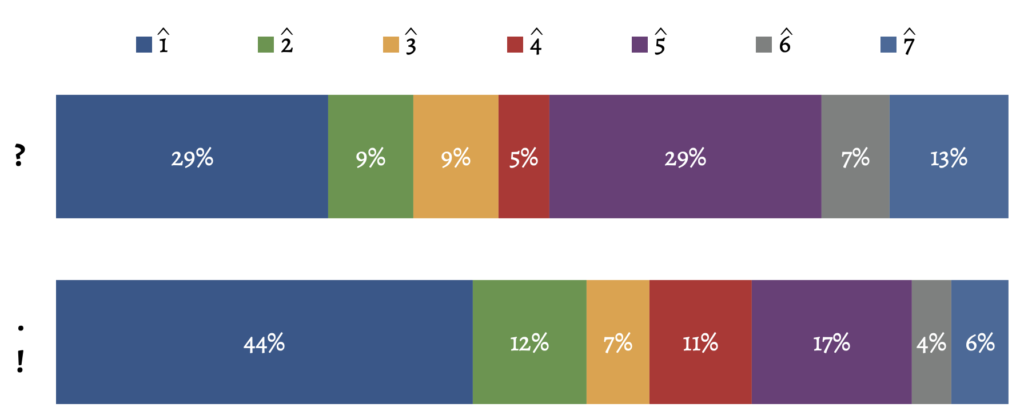
4. Placing Cadences in Formal Context
Our initial hypothesis, from Section 1.2, predicted that “the cadences which d’India employs at the close of interrogative sentences will be weaker than those he employs at the close of other sentence types.” In twice refuting the null hypothesis (H₀), the results presented above appear in large part to bear this out.
Few of the sixteenth-century theorists cited earlier provide composers with specific guidance about the appropriate handling of different sentence types. Stoquerus, for one, recommends in general terms that “in songs, the accent to be considered is not so much that of individual words as that of the entire phrase” ([ca. 1570] 1988, 205; see also Towne 1990, 282–285). His argument that the accent of an entire phrase relates closely to that of its final words suggests that he may have understood the accent of an interrogative sentence to reflect its characteristic rising intonation, but his focus remains primarily on the composer’s choice of rhythm rather than of pitch.
The only direct mention of interrogative sentences pertains to the modal degree of resolution, the only determinant of cadential strength that was found not to be statistically significant. As noted earlier, Calvisius (1592, fol. H, 3v) distinguishes between primary cadences that resolve to the final of the mode and secondary cadences that resolve to the fifth. His recommendation that composers should employ primary or “proper” cadences only at sentence endings, quoted above, precedes the argument that secondary cadences are better suited to conclude weaker sentences such as those ending with colons or question marks (Calvisius 1592, fol. I, 3v). Without statistically significant results in hand, we must remain ignorant of the practices to be found within the repertory itself. However, a substantial number of the cadences were found to resolve to other degrees of the mode (neither the final nor the fifth) despite being located at the ends of sentences. To the extent that this last observation is not an artifact of flaws in the operational definitions used in the study, it may reflect the spirit of a different theoretical maxim put forward by not Calvisius but Zarlino: “We should not always place it [i.e., the cadence] on the same degree, but rather on different degrees in order for a more pleasing and delightful music to result from the variety” (Zarlino [1558] 1965, 221, trans. Harrán 1986, 393–394).
Thus far, our examination of the five-part madrigals of Sigismondo d’India appears to substantiate the theoretical arguments of contemporaneous writers like Zarlino in ways that have rarely been observed in the music of a practicing composer outside of individual case studies. Musicologists are wise to acknowledge the historical frequency with which music theory has operated as a retrospective and indeed prescriptive endeavor, with the consequent caveat that the theory does not necessarily make fair representation of contemporaneous compositional practices. Claude V. Palisca, for one, recognized that “the laws of composition set down by Zarlino . . . evolved from an ideal view of nature, leaving the immediate facts in the distance” (1956, 85). Yet the preceding observations nevertheless provide a welcome reminder that theory and practice often share common ground.
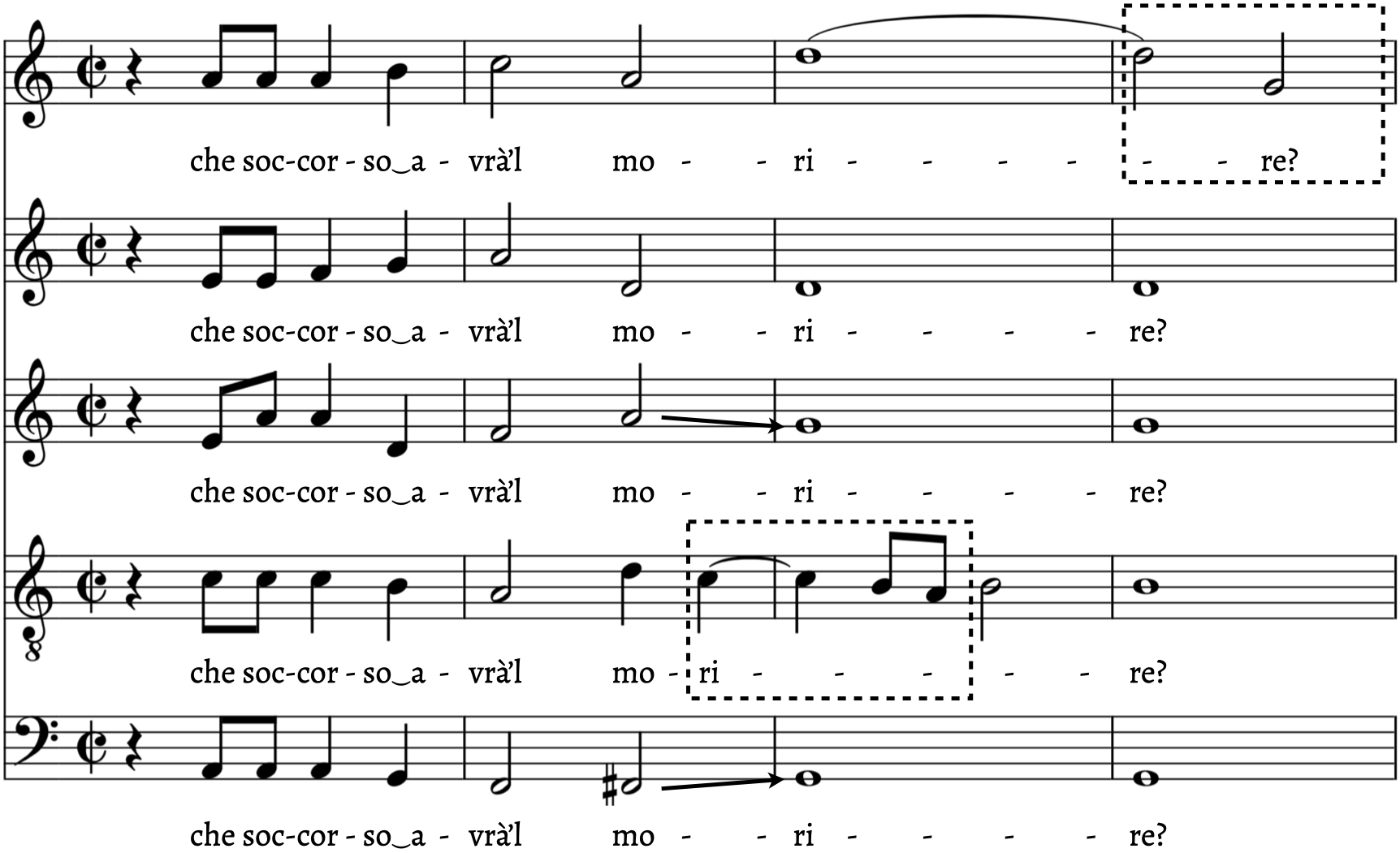
We now understand that for d’India to conclude his setting of an interrogative sentence with, say, a distorted perfect cadence (Example 3) is hardly a coincidence.21 Although the corpus contains plenty of interrogative sentences that are not accompanied by such cadential devices, the study reveals that d’India is more likely than not to employ an attenuated and non-authentic cadence in these situations. Of chief importance is that no matter which cadence the composer chooses, the observed statistical correlation establishes that he had indeed drawn a connection between sentence type and cadence strength—one that is not, we can now be sure, a mere projection on the part of the analyst.
More to the point, these results suggest that of the twenty madrigals that comprise d’India’s Third Book of 1615, it is “Dove, ah dove t’en vai?” and not “O fugace, o superba” that departs from the conventions of his cadential style. Knowing now that the composer furnishes interrogative sentence endings with full authentic cadences less than 25 percent of the time, the full authentic cadence with which he concludes “Dove” would certainly appear to be the more peculiar of the two. Such an interpretation does, however, ignore the implications of one final variable to be observed in the data already collected.
4.1 Final Cadence Types
Although our earlier examination of modal degrees of resolution did not yield statistically significant results, the method employed demonstrated the potential importance of distinguishing between final cadences and those that are interior to the madrigal. When such a distinction is applied to the observations about cadence type and fullness, a more nuanced pattern of compositional behavior comes into focus.
We must, in other words, observe how d’India chooses the type of cadence in relation to the musical context of the phrase. The results shown below compare the frequency with which the composer deploys each cadence type for sentences that end with an interior cadence (Table 5a) to those that end with a final cadence (Table 5b). Authentic cadences are heard in 74 percent of the former cases yet 93 percent of the latter. Such a comparison suggests that d’India is even more likely to close a phrase with an authentic cadence—no matter the type of sentence involved—when that cadence also closes an entire section of music. The preceding observation is statistically significant, χ2(1) = 11.68, p < .001, when measured against his use of the authentic cadence at all sentence endings (see Table 2).
| INTERIOR PHRASES | Interrogative | Other Types | All Types | |
| Galilean Cadences | 51 (91%) | 164 (98%) | 215 (96%) | |
| Authentic Cadences | 26 (46%) | 138 (83%) | 164 (74%) | |
| Perfect Cadences | 3 (5%) | 12 (7%) | 15 (7%) | |
| Phrygian Cadences | 15 (27%) | 4 (2%) | 19 (9%) | |
| Half Cadences | 7 (13%) | 10 (6%) | 17 (8%) | |
| Other Cadences | 5 (9%) | 3 (2%) | 8 (4%) | |
| Total | 56 (100%) | 167 (100%) | 223 (100%) |
| FINAL PHRASES | Interrogative | Other Types | All Types | |
| Galilean Cadences | 6 (100%) | 98 (100%) | 104 (100%) | |
| Authentic Cadences | 5 (83%) | 92 (94%) | 97 (93%) | |
| Perfect Cadences | 0 (0%) | 2 (2%) | 2 (2%) | |
| Phrygian Cadences | 1 (17%) | 4 (4%) | 5 (5%) | |
| Half Cadences | 0 (0%) | 0 (0%) | 0 (0%) | |
| Other Cadences | 0 (0%) | 0 (0%) | 0 (0%) | |
| Total | 6 (100%) | 98 (100%) | 104 (100%) |
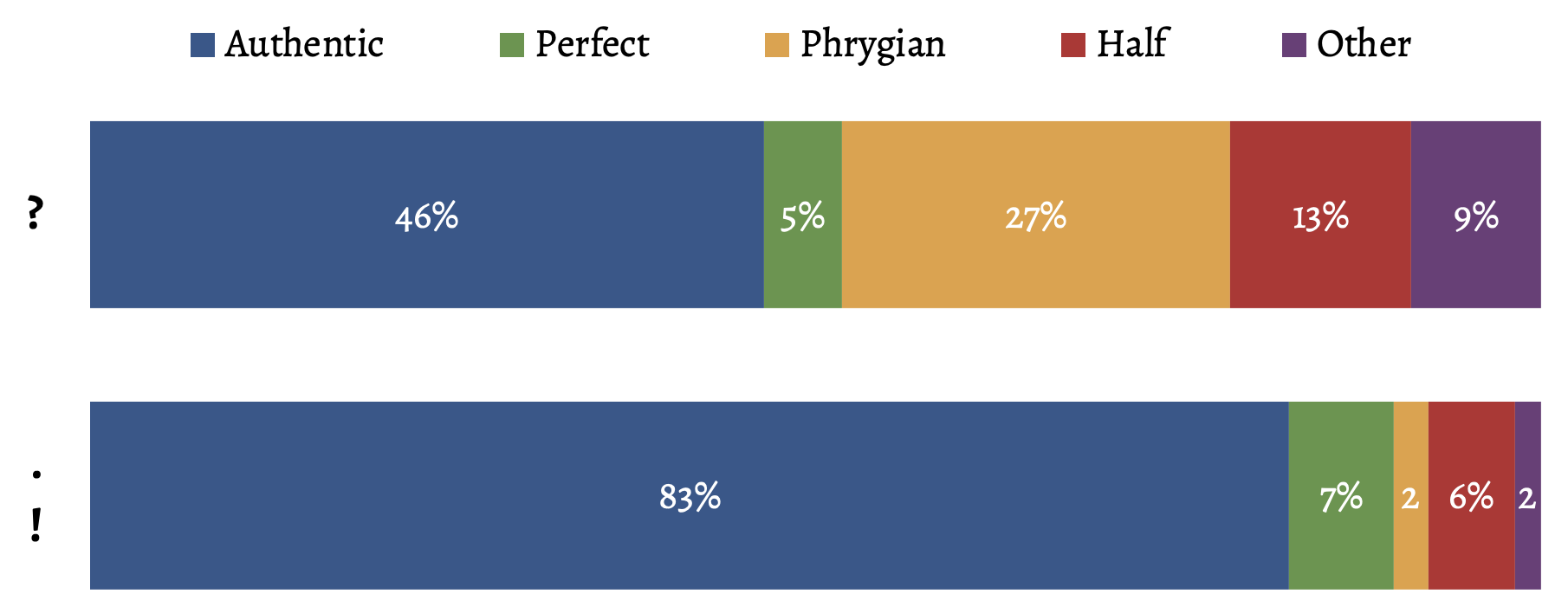
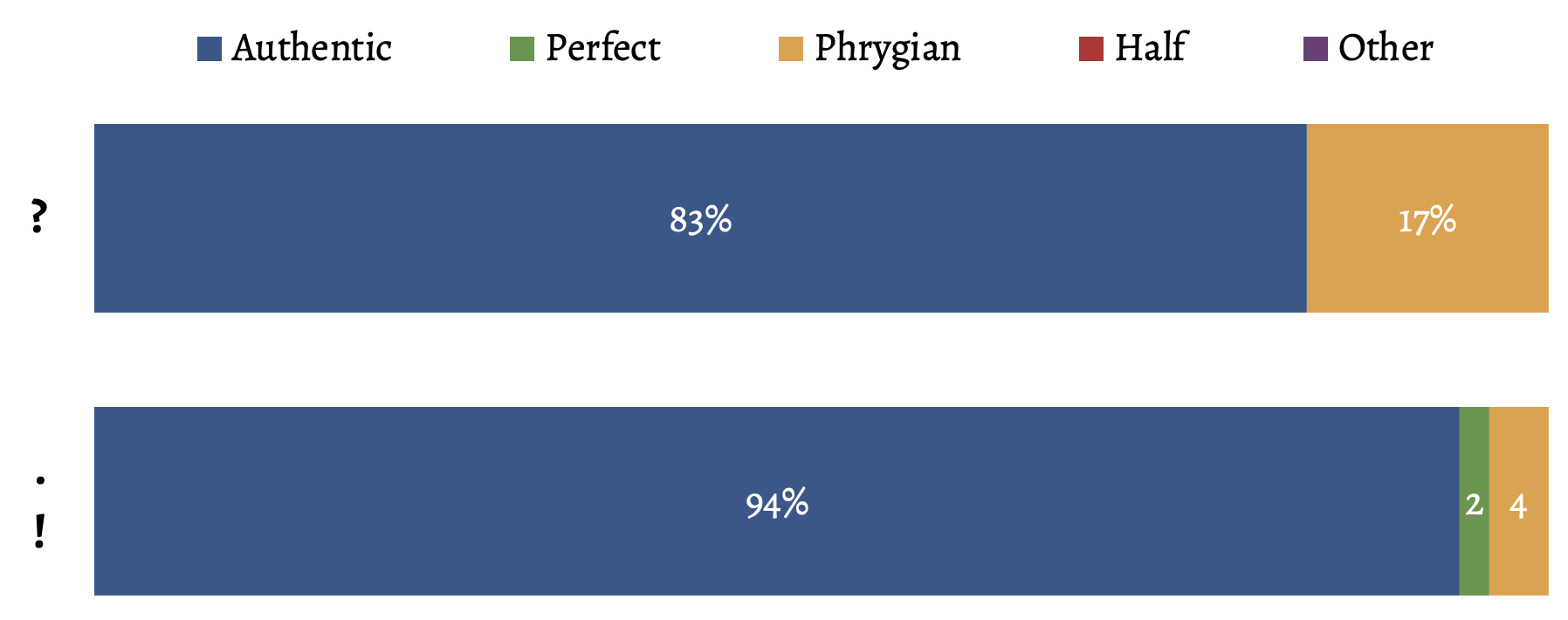
The results presented above are illustrated in Figure 4 and find support in the theoretical literature of the period. For Galilei ([1588–1591] 1980, 144), the presence of a rising semitone and powerful leap in the bass make the “virile” authentic cadence the only appropriate choice with which to conclude a piece of polyphonic music (La Via 2013, 72). He likewise recommends that contrapuntally weaker cadence types—namely those which La Via (2013, 50) has identified as perfect, Phrygian, and half—be used only in the middle of a piece and never at the end. Whereas d’India’s behavior at interior phrase endings (Table 5a) therefore continues to support the conclusions reached earlier, his behavior at final phrase endings (Table 5b) would seem to reveal a overriding preference for the use of authentic cadences regardless of whether or not the sentence is interrogative.
4.2 Fullness of Final Cadences
In parallel with the preceding discussion of cadence types, we may also distinguish between the frequency with which d’India uses techniques of cadential attenuation for sentences that end with an interior cadence (Table 6a) and for sentences that end with a final cadence (Table 6b). The comparison again reveals the composer’s orthodox treatment of final cadences: not only are they more likely to be authentic, but they are more likely to be full (i.e., without attenuation) as well. See Example 4 in the Appendix. His preference for full cadences at final phrases is indeed statistically significant, χ2(1) = 46.97, p < .001, when measured against his use of full cadences at all sentence endings (see Table 3).
| INTERIOR PHRASES | Interrogative | Other Types | All Types | |
| Full Cadences | 16 (29%) | 90 (54%) | 106 (48%) | |
| Attenuated Cadences | 39 (71%) | 78 (46%) | 117 (52%) | |
| 1. Evaporated | 8 (15%) | 23 (14%) | 31 (14%) | |
| 2. Interrupted | 4 (7%) | 4 (2%) | 8 (4%) | |
| 3. Distorted | 22 (40%) | 44 (26%) | 66 (30%) | |
| 4. Synecdochic | 5 (9%) | 7 (4%) | 12 (5%) | |
| Evaded Cadences | 0 (0%) | 0 (0%) | 0 (0%) | |
| Total | 55 (100%) | 168 (100%) | 223 (100%) |
| FINAL PHRASES | Interrogative | Other Types | All Types | |
| Full Cadences | 5 (83%) | 94 (96%) | 99 (95%) | |
| Attenuated Cadences | 1 (17%) | 4 (4%) | 5 (5%) | |
| 1. Evaporated | 0 (0%) | 1 (1%) | 1 (1%) | |
| 2. Interrupted | 0 (0%) | 0 (0%) | 0 (0%) | |
| 3. Distorted | 0 (0%) | 3 (3%) | 3 (3%) | |
| 4. Synecdochic | 1 (17%) | 0 (0%) | 1 (1%) | |
| Evaded Cadences | 0 (0%) | 0 (0%) | 0 (0%) | |
| Total | 6 (100%) | 98 (100%) | 104 (100%) |
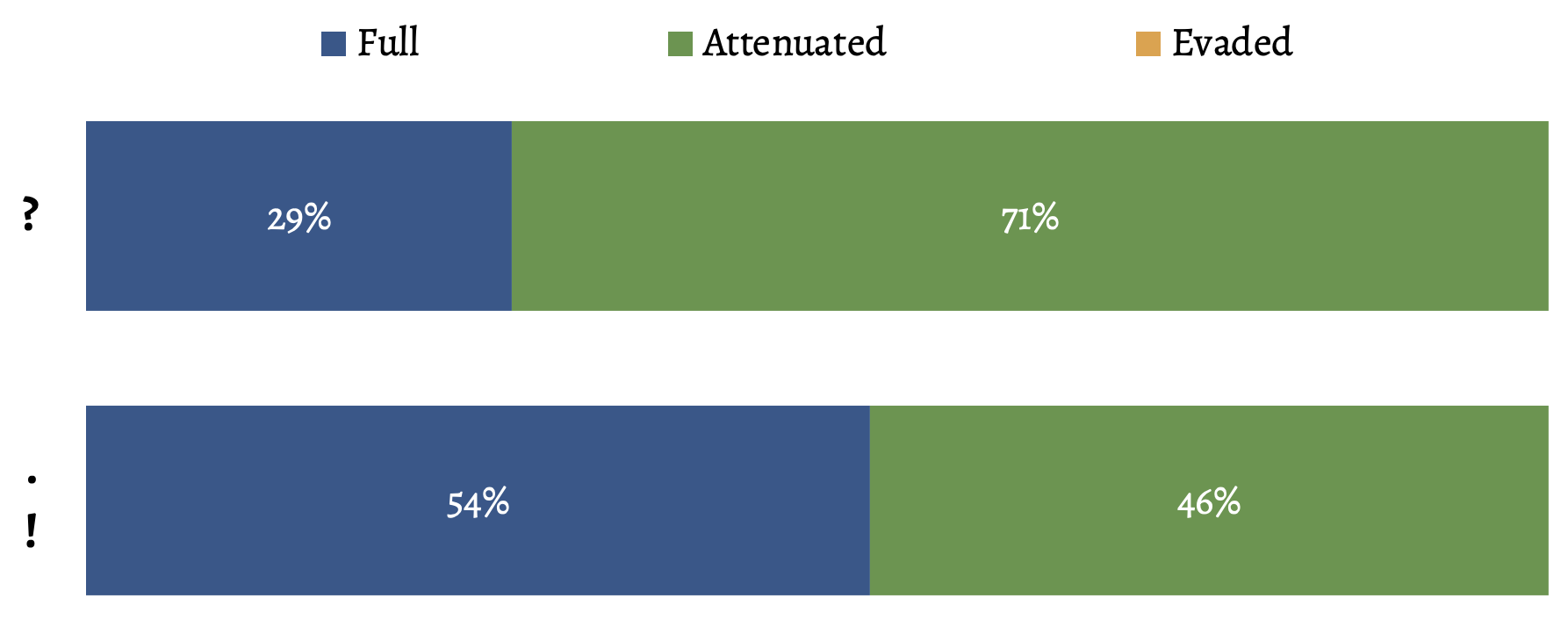
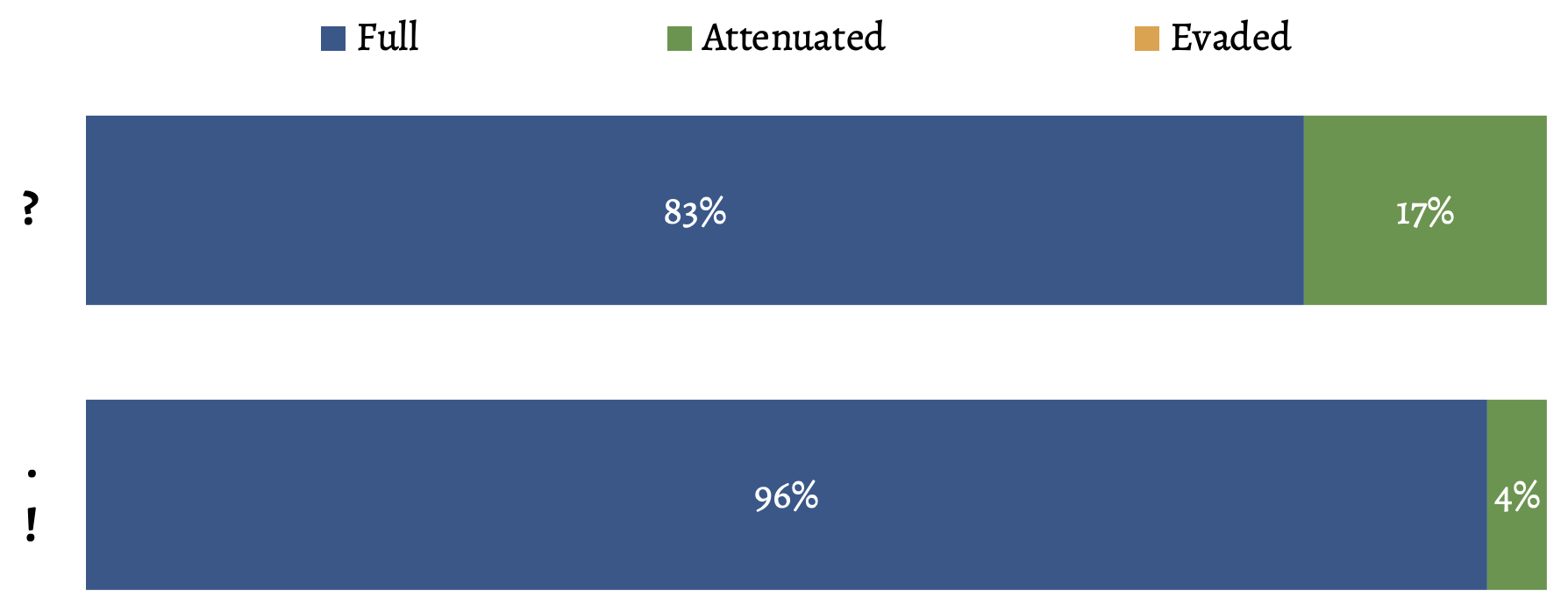
The preceding observations, illustrated in Figure 5, again find some support in the literature, although the topic hardly seems to have commanded much attention from theorists then or now. Zarlino (1558, 224) does recommend that certain “diminished” (Diminuite) cadences should be employed “in the middle of a work, and not at the end,” but only with regard to cadences that involve a leap of a fourth or a fifth within a two-voice texture. He provides no such advice in his later discussion of cadences within a texture of three or four voices (249–250).
As with his choice of cadence types, d’India’s behavior at interior phrase endings (Table 6a) here remains consistent with the conclusions reached earlier, while his behavior at final phrase endings (Table 6b) now suggests a strong inclination towards the use of full cadences no matter the type of sentence.
5. Conclusion
The above observations hardly negate the general conclusions reached in Section 3—namely, that d’India often tends to employ weaker cadences at the ends of interrogative sentences. They do, however, establish that the compositional calculus changes significantly in the context of final cadences with regard to both cadence type and fullness. The faithfulness with which d’India employs full authentic cadences at the ends of his madrigals demonstrates one circumstance in which musical considerations would seem to outweigh the appropriate treatment of the text even when the final sentence is interrogative in nature.
The results of this corpus study therefore both admit and refute the hypothesis proposed at the outset: with the glaring exception of the final cadences, there is little in the data to suggest that Sigismondo d’India did not treat interrogative sentences differently from sentences of other types. Although the results generally disprove the null hypothesis, it is important to remember that they do not prove—in fact, could never have proven—our actual hypothesis. As in any formal empirical study, there always remains the possibility that other factors are responsible for having caused the differences observed above.
For example, is it possible that d’India sometimes considers a short interrogative phrase to end with the equivalent of not a period but a comma? The composer may well employ weaker cadences at commas and unmarked line endings in order to signal his listeners that the entire sentence remains incomplete. Such an idea seems plausible, especially in consideration of the line from “O fugace, o superba” that was found to comprise three interrogative sentences in a row. On the other hand, we may observe a number of short phrases in the corpus that end with periods as well. The question has yet to be explored.
There also remain alternative methods by which to measure the relative strength of the cadences. For example, a subsequent study might examine their rhythmic perfection, the characteristic pattern of syncopation that La Via (2013, 50) has also shown to communicate “assertive power” for Galilei. It follows from the same hypothesis that d’India would be more likely to eschew such perfection in the cadences that he composes at the ends of interrogative sentences than at the ends of others. The present study does not address this characteristic in part because one tends to recognize the sound of an interrogative sentence through not its rhythm but its pitch. But given the extent to which perfection can function as another marker of cadential strength, and with due regard to Stoquerus’s ([ca. 1570] 1988, 205) support for the rhythmic retardation of phrase endings, a future study of the corpus may reveal it to be significant nonetheless.
Finally, the present study has much to teach us about the compositional sensibilities of Sigismondo d’India, but only in general terms. All else being equal, we can reasonably assert that d’India is less likely to employ a full authentic cadence to end a sentence in the text when that sentence is an interrogative one. That is the trend. All else is rarely equal, however, and we must again acknowledge that this sort of statistical study can do little to reveal why the composer may have chosen to construct a particular cadence in the music to accompany the ending of a particular sentence in the text. The specific artistic circumstances that will have precipitated any such compositional decision remain both countless in number and unpredictable in their collective effect. For example, what to make of the four Phrygian cadences, two of them attenuated, that populate the middle column of Table 5b? Each accompanies a non-interrogative sentence and comes at the end of the music, yet d’India abandons his observed tendency to provide an authentic cadence in those places. The decision may arise from his reading of the text, from compositional decisions taken earlier in the piece, or from considerations entirely unanticipated by the historian.
Yet these mysteries hardly detract from the importance of the overall pattern that the results presented here have revealed, a pattern that would have been difficult to verify without quantitative means. The study has established that a composer of the late Renaissance relied upon a consistent strategy of musical representation in order to realize the syntactic and prosodic implications of the texts that lay before him. With regard to the legacy of d’India himself, scholars such as Giuseppe Collisani (1998, 39) have long proclaimed “the very clear articulation of the madrigal in different sections that, corresponding to the various logical units of the poetic text, highlight its caesure and connections” to be a particular strength of his musical style. We now have the opportunity to appreciate the care with which the same composer articulates smaller syntactic units as well. The newly revealed techniques by which d’India manipulates cadential strength when setting interrogative sentences significantly expand our knowledge of how a composer of sixteenth- and early seventeenth-century polyphony heard, and thus allowed his listeners to hear, the syntactic design of a text.
Equipped with such knowledge, let us now return to the pair of examples with which the study began. At first glance, d’India’s compositional approach had appeared to corroborate Monteverdi’s assertion that in music of the seconda pratica, the words have indeed become the master (padrona) of the harmony. That the observed pattern disappears in the context of final cadences means, however, that the cadence which concludes “Dove, ah dove t’en vai?” is not the compositional anomaly we may have supposed. Nearly all of the madrigals in the corpus end with a full, non-attenuated authentic cadence, even when the final sentence is interrogative.
“O fugace, o superba,” closing as it does with an attenuated Phrygian cadence, again becomes the odd one out. There are, in fact, only five attenuated final cadences of any type to be found throughout the entire corpus of 85 madrigals. Not one of the other four coincides with an interrogative sentence ending (see Example 10 in the Appendix). Such cadences are therefore the idiosyncratic exceptions that prove the rule. Contrary to the spirit of Monteverdi’s claim, the present study makes clear that d’India usually gives the music priority over the words at his final cadences. When the composer is faced with a choice between communicating the sense of the words and honoring the musical conventions of the genre, the music almost always wins out in the end. Perhaps the harmony is not the servant but the master, after all.
Appendix: Operational Definitions of Full and Attenuated Cadence Types
The operational definitions that the present study has employed in order to identify types of full and attenuated cadences are provided below, with select musical examples. Definitions for the four basic cadence types—authentic, perfect, Phrygian, and half—are based on musical exemplars published by Stefano La Via (2013, 51). Definitions for the various techniques of cadential attenuation—evaporation, interruption, distortion, and synecdoche—are based on those described by John Turci-Escobar (2007, 108). The application of those techniques of attenuation to the four basic cadence types has produced the operational definitions printed below.
To be clear, the purpose of each operational definition is not to capture the theoretical essence of a particular cadence type. Instead, its purpose is to provide an objective diagnostic tool with which one may somewhat mechanically categorize most of the cadences to be found within the corpus. For example, the following definition of a full authentic cadence makes no mention of the fact that the final harmony is likely to include the interval of a perfect fifth above the structural pitch of resolution, even though this quality may be considered essential to a theoretical understanding of the cadence type.
An operational definition was not constructed for the interrupted half cadence because, unlike the other cadence types, its typical penultimate harmony does not necessarily suggest that the musical phrase will end in a half cadence. Neither was an operational definition constructed for the synecdochic half cadence because the (full) half cadence type has itself been operationalized to contain only one distinguishing feature: the falling semitone. In a sense, the cadence (as defined for the purposes of this study) is therefore already synecdochic.
Full Cadence Types
Full Authentic Cadence. Stepwise contrary motion to the octave or the unison between two upper voices, one of which features a rising semitone, together with the leap of a rising perfect fourth or falling perfect fifth to the same pitch class in the lowest voice (see Example 4).22 The voices share a simultaneous moment of resolution, except in cases where a pitch shared by both of the harmonies is sustained through the resolution. The definition also admits an implied stepwise descent in the upper voices when a different voice supplies the second pitch.
Full Perfect Cadence. Stepwise contrary motion to the octave or the unison between two voices, one of which features a rising semitone, without the leap of a perfect fourth or fifth to the same pitch class in the lowest voice (see Example 5). The voices share a simultaneous moment of resolution, except in cases where a pitch shared by both of the harmonies is sustained through the resolution. The definition also admits an implied stepwise descent when a different voice supplies the second pitch.
Full Phrygian Cadence. Stepwise contrary motion to the octave or the unison between two voices, one of which features a falling semitone (see Example 6). The voices share a simultaneous moment of resolution, except in cases where a pitch shared by both of the harmonies is sustained through the resolution. The definition also admits an implied stepwise ascent when a different voice supplies the second pitch.
Full Half Cadence. Presence of a falling semitone in one voice, without contrary motion to the same pitch class in another, as the voice moves to the third of the final harmony (see Example 7). (Such consideration of the harmonic context is necessary in order to distinguish this cadence from the synecdochic Phrygian cadence, below.) The voices move simultaneously to the final harmony of the phrase, except in cases where a pitch shared by the penultimate harmony is sustained.
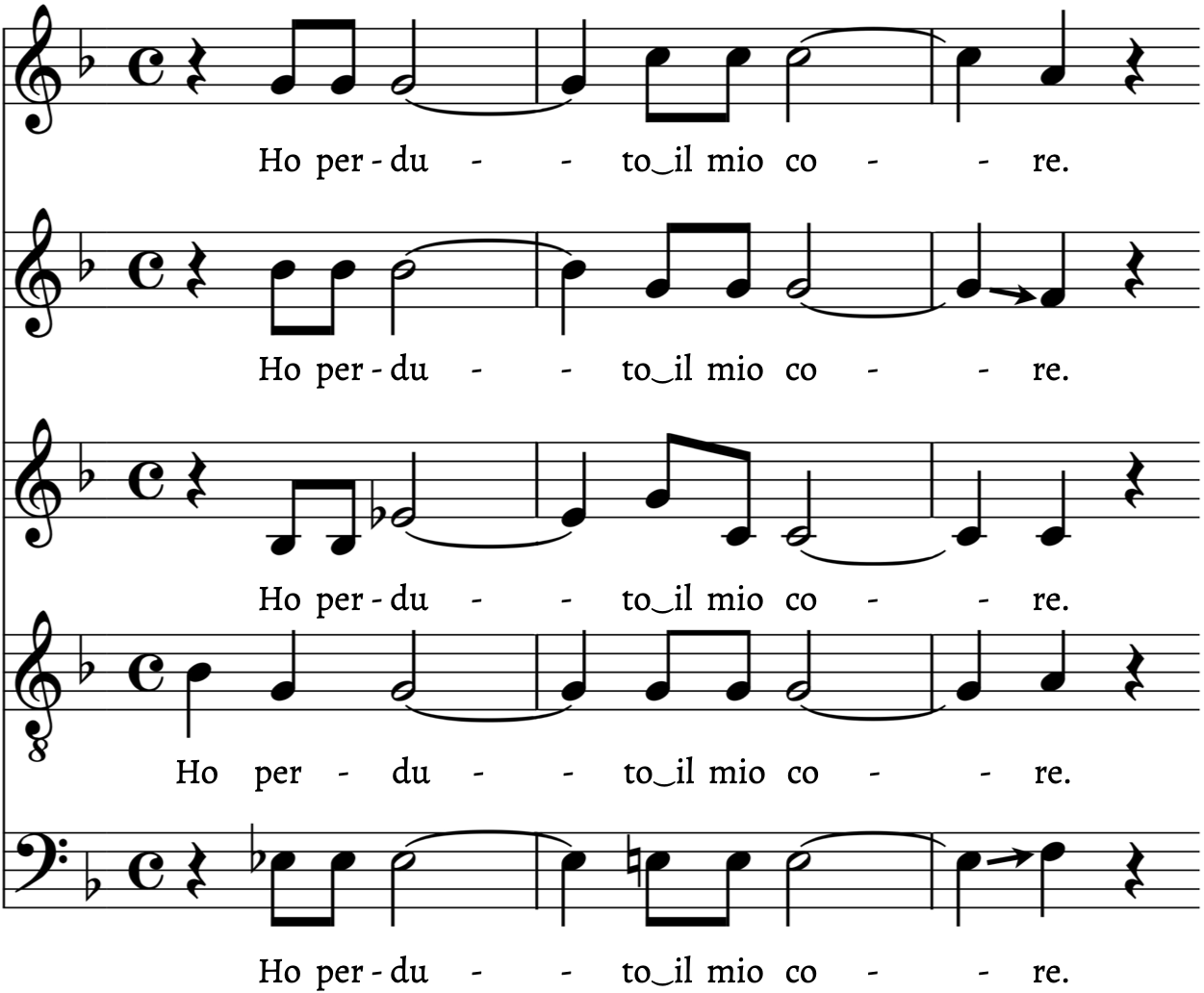
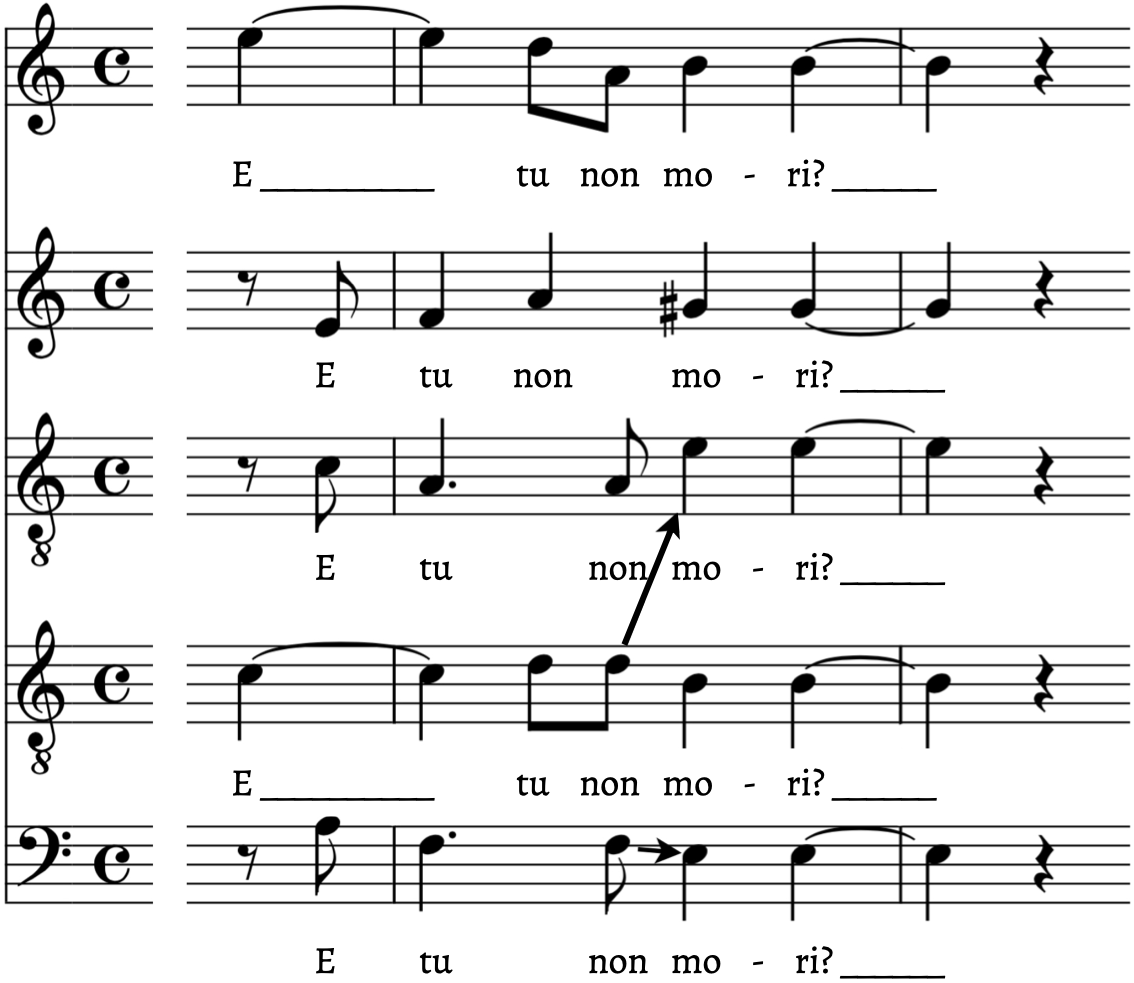
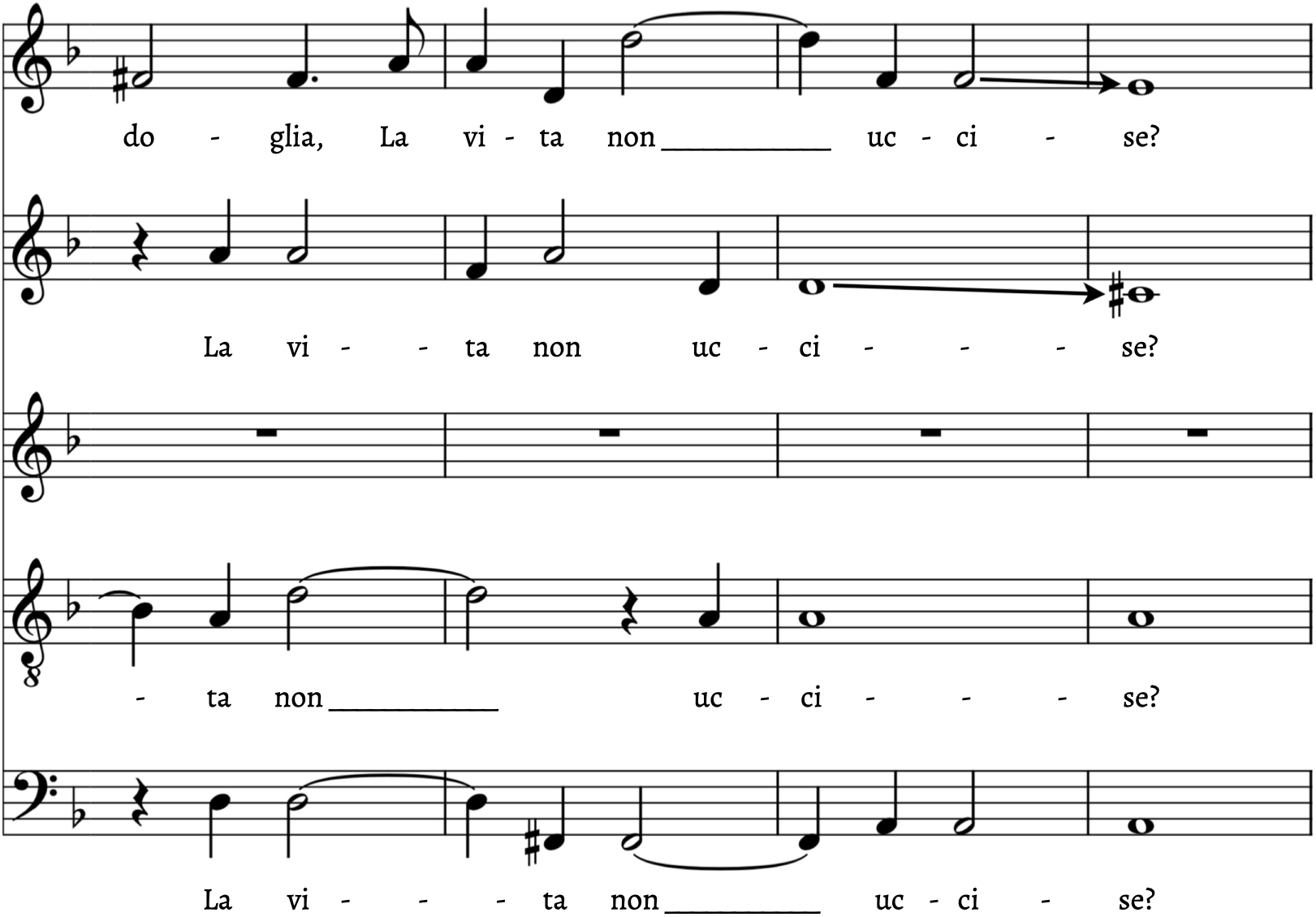
Evaporated Cadence Types
Evaporated Authentic Cadence. Some but not all of the voices fall silent at the moment of resolution (see Example 8). The lowest voice either completes its leap or ends early in a position to have completed it.23
Evaporated Perfect Cadence. Some but not all of the voices fall silent at the moment of resolution. At least one of the two structural voices provides a rising semitone or falling whole tone, while the second voice (if falling silent) ends in a position to have provided the other. No evident preparation of a leap by perfect fourth or fifth to the same pitch class in the lowest voice.
Evaporated Phrygian Cadence. Some but not all of the voices fall silent at the moment of resolution. At least one of the two structural voices provides a falling semitone or rising whole tone, while the second voice (if falling silent) ends in a position to have provided the other.
Evaporated Half Cadence. Some but not all of the voices fall silent at the moment of resolution. The falling semitone is present, without a second voice moving in stepwise contrary motion or falling silent in a position to have provided it.
Interrupted Cadence Types
Interrupted Authentic Cadence. All of the voices fall silent at the expected moment of resolution (see Example 9). The three structural voices end in positions that would have accommodated the necessary resolution. The rhythmic perfection of a 4–3 suspension distinguishes this cadence from the full half cadence, in which the voices move simultaneously to the final harmony.
Interrupted Perfect Cadence. All of the voices fall silent at the expected moment of resolution. Both structural voices end in positions that would have accommodated the necessary contrary motion.
Interrupted Phrygian Cadence. All of the voices fall silent at the expected moment of resolution. Both structural voices end in positions that would have accommodated the necessary contrary motion.
Distorted Cadence Types
Distorted Authentic Cadence. All three of the structural voices complete the cadence, but some voices are rhythmically misaligned and/or provide unconventional harmonies at the moment of resolution. An unconventional harmony is understood to be any pitch that does not fall within the expected major triad. Alternately, the harmony lacks the major third.
Distorted Perfect Cadence. Both of the structural voices complete the cadence, but some voices are rhythmically misaligned and/or provide unconventional harmonies at the moment of resolution. Alternately, the harmony lacks the major third.
Distorted Phrygian Cadence. Both of the structural voices complete the cadence, but some voices are rhythmically misaligned and/or provide unconventional harmonies at the moment of resolution (see Example 10). Alternately, the harmony lacks the major third.
Distorted Half Cadence. The falling semitone (to the third of the final harmony) is heard in one voice, without contrary motion to the same pitch class in another, but some voices are rhythmically misaligned and/or provide unconventional harmonies at the end of the phrase.
Synecdochic Cadence Types
Synecdochic Authentic Cadence. Leap of a rising perfect fourth or falling perfect fifth in the lowest voice, without at least one of the other structural voices.
Synecdochic Perfect Cadence. The rising semitone is heard in one voice, without the expected stepwise contrary motion and without the leap of a perfect fourth or fifth to the same pitch class in the lowest voice (see Example 11).
Synecdochic Phrygian Cadence. The falling semitone is heard in one voice, without stepwise contrary motion to the same pitch class, as the voice resolves to the root or to the fifth of the final harmony. (Such consideration of the harmonic context is necessary in order to distinguish this cadence from the full half cadence, above.)
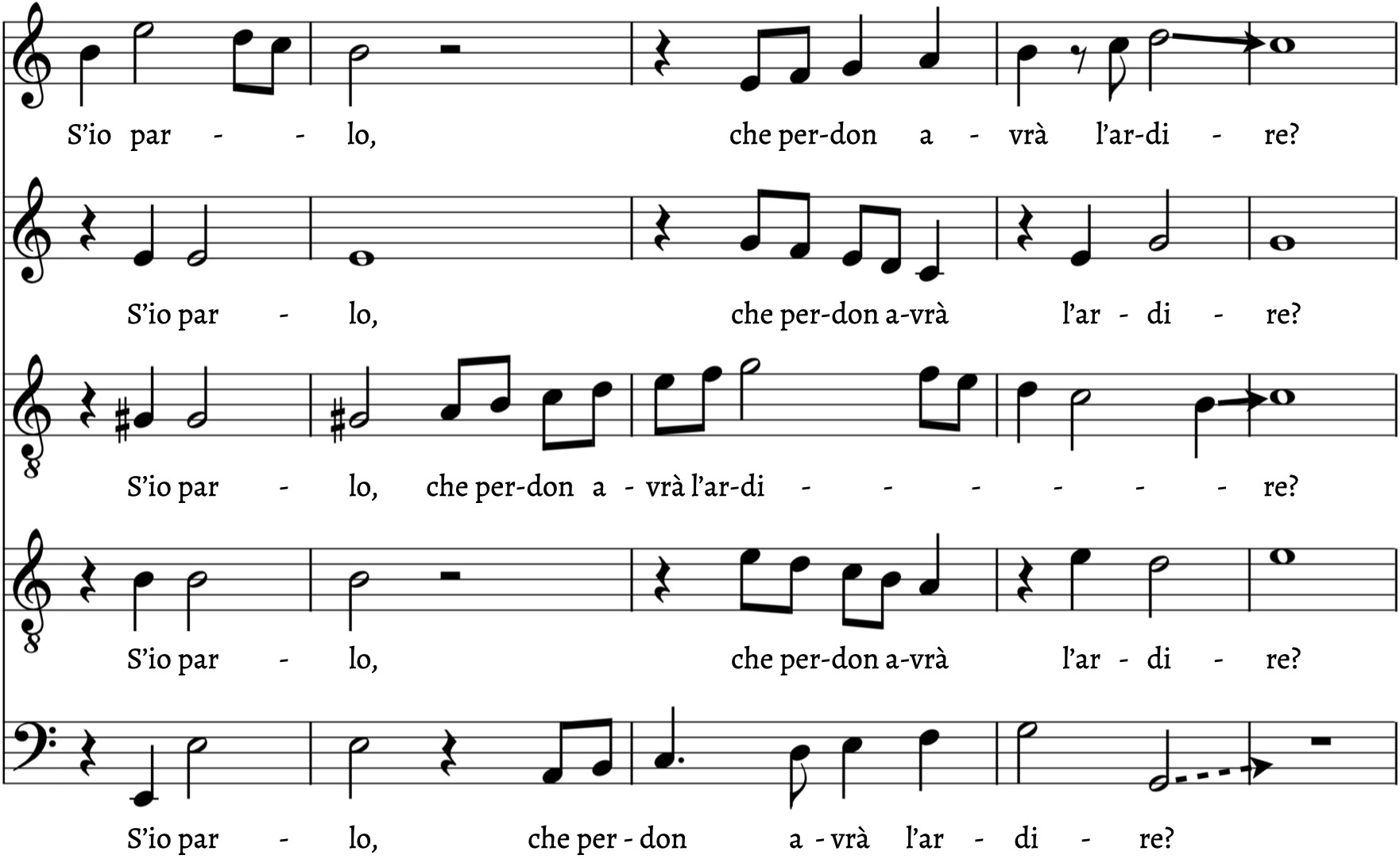
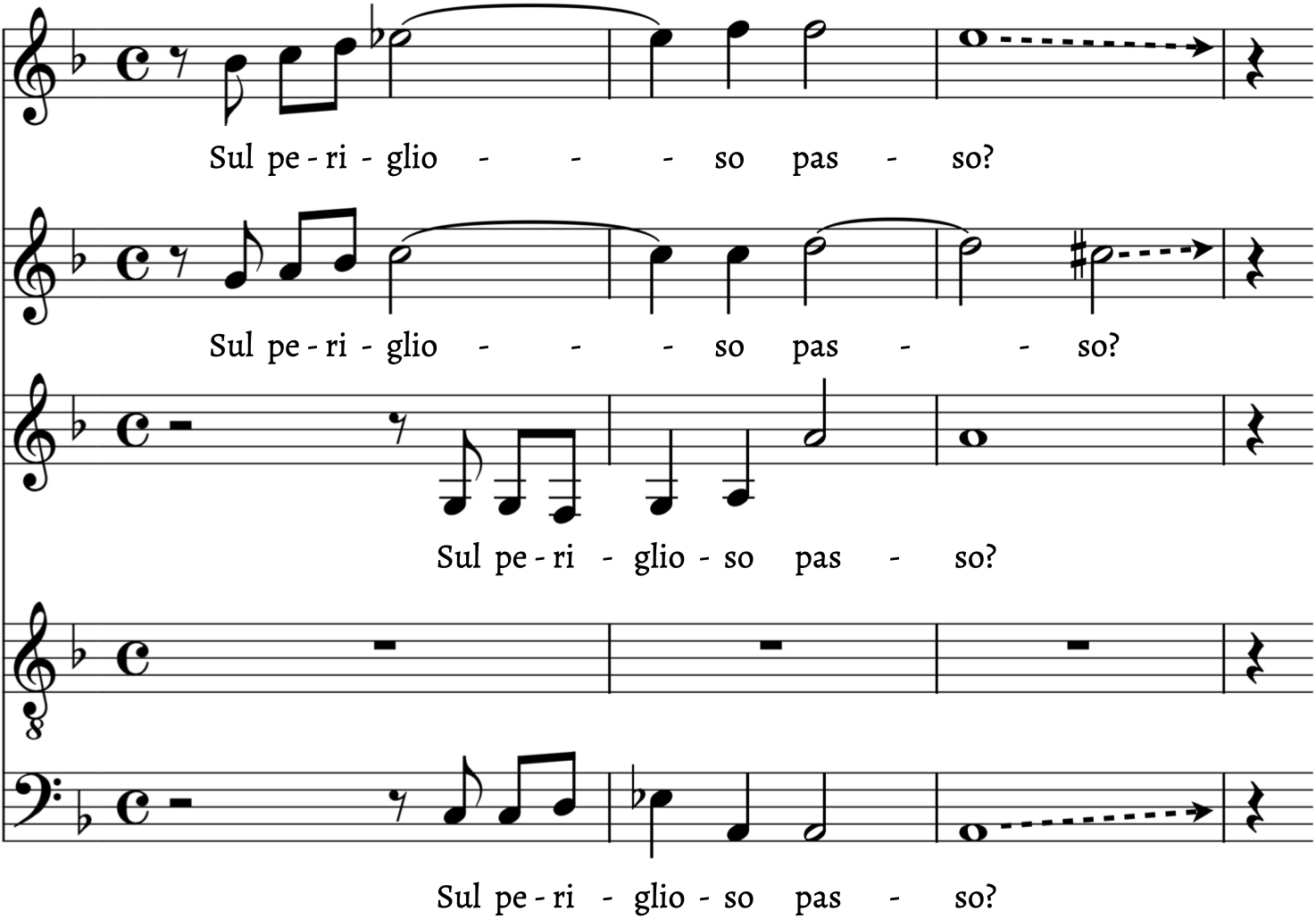
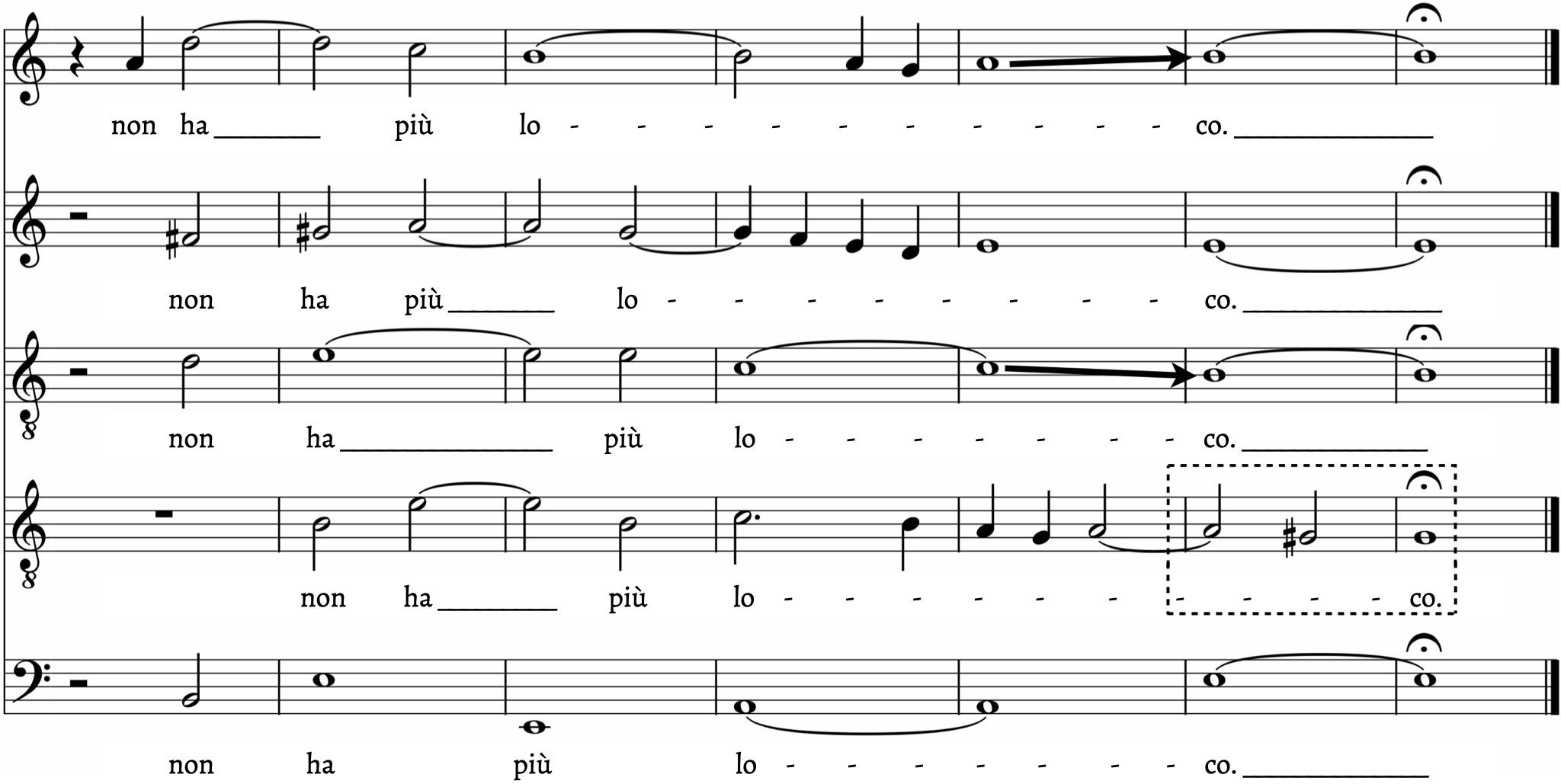
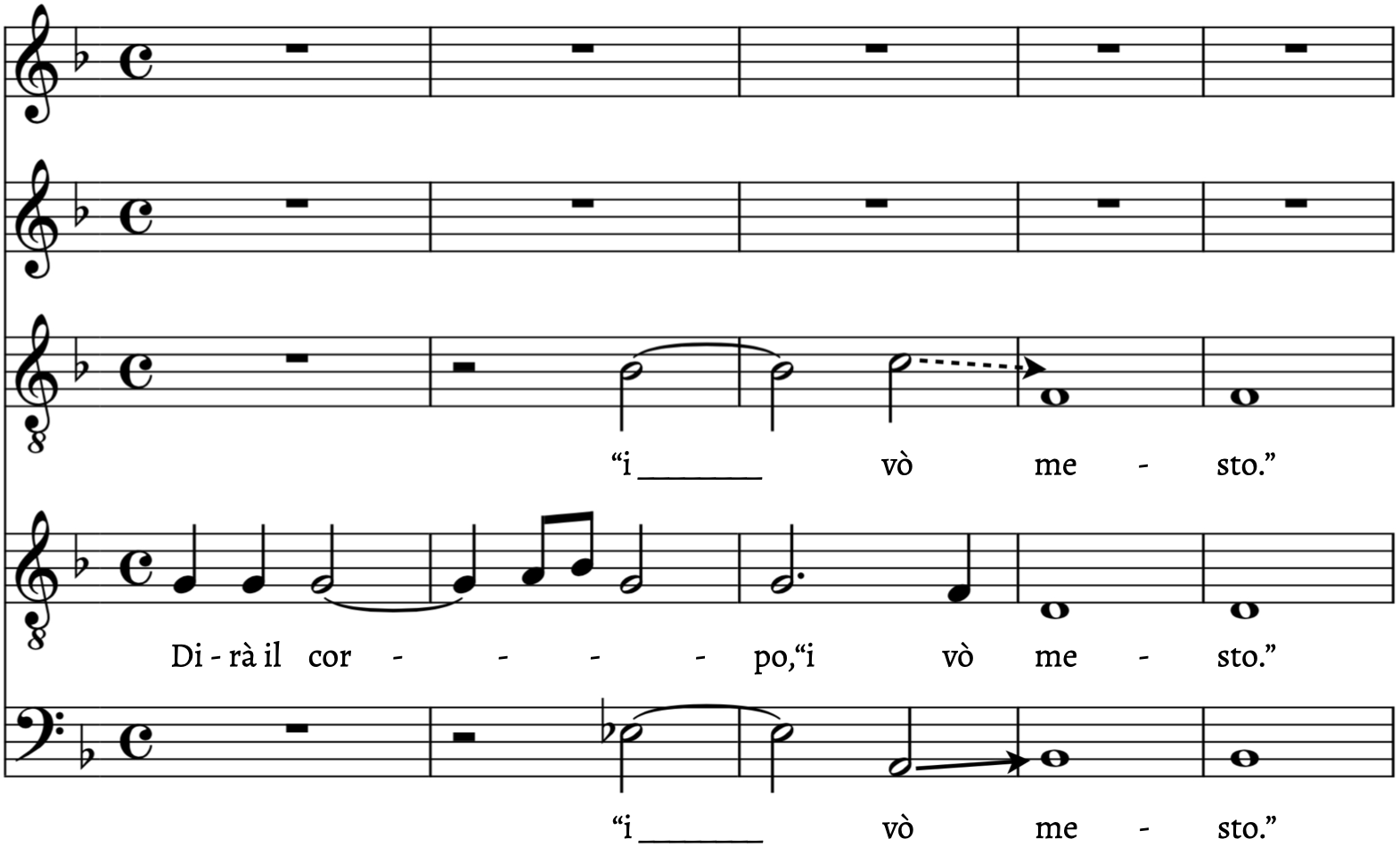
References
Berger, Karol. 1987. Musica ficta: Theories of accidental inflections in vocal polyphony from Marchetto da Padova to Gioseffo Zarlino. Cambridge: Cambridge University Press.
Burkholder, J. Peter, and Claude V. Palisca, eds. 2014. Norton Anthology of Western Music Volume 1: Ancient to Baroque. 7th edition. New York: W. W. Norton.
Calvisius, Seth. 1592. MEΛOΠOIIA [Melopoeia] sive melodiae condendae ratio, quam vulgò musicam poëticam vocant, ex veris fundamentis extructa et explicata. Erfurt: Georg Baumann. http://catalogue.bnf.fr/ark:/12148/cb306723512.
Chapallaz, Marguerite. 1964. “Notes on the Intonation of Questions in Italian.” In In Honour of Daniel Jones: Papers Contributed on the Occassion of his Eightieth Birthday, 12 September 1961. Edited by David Abercrombie et al. London: Longmans.
Collisani, Giuseppe. 1998. Sigismondo d’India. Palermo: L’Epos.
Coluzzi, Seth J. 2013. “Black Sheep: The Phrygian Mode and a Misplaced Madrigal in Marenzio’s Seventh Book (1595).” The Journal of Musicology 30, no. 2 (Spring): 129–179.
———. 2015. “Speaking In (and Out of ) Mode: Structure and Rhetoric in Marenzio’s O Mirtillo, Mirtillo anima mia (1595).” Music Theory Spectrum 37: 253–274.
Dahlhaus, Carl. 1990. Studies on the Origin of Harmonic Tonality. Translated by Robert O. Gjerdingen. Princeton: Princeton University Press.
Decker, Gregory J. 2014–15. “Strategies for Opposition, Ambiguity, and ‘Amarilli’ in the Seconda Pratica Italian Madrigal.” Intégral 28–29: 181–219.
DeFord, Ruth I. 1985. “Musical Relationships between the Italian Madrigal and Light Genres in the Sixteenth Century.” Musica Disciplina 39: 107–168.
d’India, Sigismondo. (1606) 1997. The First Book of Madrigals for Five Voices. Vol. 1 of The First Five Books of Madrigals. Ed. John Steele and Suzanne Court. Translations by Barbara Reynolds. New York: Gaudia Music and Arts.
———. 1609. Le Musiche . . . da cantar solo. Milan: Heirs of Simon Tini and Filippo Lomazzo.
———. (1611) 1997. The Second Book of Madrigals for Five Voices. Vol. 2 of The First Five Books of Madrigals. Ed. John Steele and Suzanne Court. Translations by Barbara Reynolds. New York: Gaudia Music and Arts.
———. (1615) 1998. The Third Book of Madrigals for Five Voices and Basso Continuo. Vol. 3 of The First Five Books of Madrigals. Ed. John Steele and Suzanne Court. Translations by Barbara Reynolds. New York: Gaudia Music and Arts.
———. (1616) 1999. The Fourth Book of Madrigals for Five Voices. Vol. 4 of The First Five Books of Madrigals. Ed. John Steele and Suzanne Court. Translations by Barbara Reynolds. New York: Gaudia Music and Arts.
———. (1616) 2000. The Fifth Book of Madrigals for Five Voices. Vol. 5 of The First Five Books of Madrigals. Ed. John Steele and Suzanne Court. Translations by Barbara Reynolds. New York: Gaudia Music and Arts.
Fromson, Michèle. 1991. “Cadential Structure in the Mid-Sixteenth Century: The Analytical Approaches of Bernhard Meier and Karol Berger Compared.” Theory and Practice 16: 179–213.
Galilei, Vincenzo. (1588–1591) 1980. Die Kontrapunkttraktate Vincenzo Galileis. Edited by Frieder Rempp. Cologne: Arno Volk Verlag Hans Gerig.
Guarini, Battista. 1598. Rime. Venice: Ciotti.
———. 1737. Rime. Vol. 2 of Opere. Verona: G. A. Tumermani.
Harrán, Don. 1986. Word-Tone Relations in Musical Thought: From Antiquity to the Seventeenth Century. Neuhausen-Stuttgart: Hänssler.
Joyce, John, and Glenn Watkins. “D’India, Sigismondo.” Grove Music Online. Oxford Music Online. Oxford: Oxford University Press, 2001. Accessed June 5, 2018.
Joyce, John J. 1981. The Monodies of Sigismondo d’India. Ann Arbor: UMI Research Press.
La Via, Stefano. 2013. “Alfonso Fontanelli’s Cadences and the Seconda Pratica.” The Journal of Musicology 30, no. 1 (Winter): 49–102.
Marino, Giambattista. 1611. Rime. Vol. 2. Venice: Giunti.
———. 1627. Egloghe boscherecce. Milan: Giovanni Battista Cerri. First published 1620.
Meier, Bernhard. 1988. The Modes of Classical Vocal Polyphony, Described According to the Sources. Translated by Ellen S. Beebe. New York: Broude Brothers.
———. 1990. “Rhetorical Aspects of the Renaissance Modes.” Translated by Geoffrey Chew. Journal of the Royal Musical Association 115, no. 2: 182–190.
Monteverdi, Giulio Cesare. 1607. Foreword to Claudio Monteverdi, Scherzi Musicali. Venice.
Palisca, Claude V. 1956. “Vincenzo Galilei’s Counterpoint Treatise: A Code for the Seconda Pratica.” Journal of the American Musicological Society 9, no. 2: 81–96.
Parkes, Malcolm B. 1993. Pause and Effect: An Introduction to the History of Punctuation in the West. Berkeley: University of California Press.
Stoquerus, Gaspar. (c. 1570) 1988. Musica verbali libri duo: Two Books on Verbal Music. Edited by Albert C. Rotola. Lincoln: University of Nebraska Press.
Strykowski, Derek R. 2016.“Text Painting, or Coincidence? Treatment of Height-Related Imagery in the Madrigals of Luca Marenzio.” Empirical Musicology Review 11, no. 2: 109–119. https://doi.org/10.18061/emr.v11i2.4903.
Swain, Joseph P. 1997. Musical Languages. New York: Norton.
Taruskin, Richard. 2010. Music from the Earliest Notations to the Sixteenth Century. The Oxford History of Western Music 1. Oxford: Oxford University Press.
Tasso, Torquato. 2010. Rhymes of Love. Translated by Maria C. Pastore Passaro. Edited by Maria Henry and Susette Acocella. Ottawa: Legas.
Tonani, Elisa. 2011. “Punto interrogativo.” Enciclopedia dell’Italiano. Treccani. http://www.treccani.it/enciclopedia/. Accessed June 13, 2018.
Towne, Gary. 1990. “A Systematic Formulation of Sixteenth-Century Text Underlay Rules (Part I of II).” Musica Disciplina 44: 255–287.
Turci-Escobar, John. 2007. “Softening the Edges: Cadential Attentuation in Gesualdo’s Six Books of Madrigals.” Theory and Practice 32: 101–135.
———. 2011. “Keeping Up with the Words: Expressive Phrase Overlapping in the Late Italian Madrigal.” Music Analysis 30, nos. 2–3: 152–185.
Wiering, Frans. 2001. The Language of the Modes: Studies in the History of Polyphonic Modality. New York: Routledge.
Zarlino, Gioseffo. (1558) 1965. Le istitutioni harmoniche. Venice. Facsimile edition. New York: Broude Brothers.
———. (1558) 1968. The Art of Counterpoint: Part Three of Le istitutioni harmoniche, 1558. Trans. Guy A. Marco and Claude V. Palisca. New Haven: Yale University Press.
Notes
- The edition prints the tenor syllable “-li” beneath a rest, an error that has been corrected in Example 1.
- Translations of all poetry that d’India has set to music are by Barbara Reynolds, here and throughout the article, and appear in the modern d’India edition cited above (1997–2000). Section 2 discusses both the sources of the poetry and the accuracy of such translations.
- Galilei himself does not employ such contemporary terminology to identify the four cadence types, but I follow La Via’s lead in using the abovementioned labels as a convenient shorthand throughout the present article. Operational definitions for each of the cadence types are provided in the Appendix.
- “The semantic use of cadences is particularly prevalent in the polyphonic repertoire of the sixteenth-century Italian madrigal” (La Via 2013, 49ff).
- The identity of the Sixth Book remains uncertain, the Seventh is missing a voice part, and the Eighth is composed entirely in the concertato style. See editors’ preface to d’India ([1606] 1997, vii).
- Of course, the peril of such an approach is that it takes for granted that the punctuation found in the edition’s poetry is itself reliable. An anonymous reviewer has discovered at least one mistake. The poem is Battista Guarini’s “Hoggi nacqui, ben mio,” which d’India sets in his Fifth Book of 1616. As printed at the beginning of the score, the final lines of the poem read “O fortunato il mio natal, se vui/Direte con la lingua, e col desio./Hoggi nacque il ben mio” (d’India [1616] 2000, 97). The period that follows “desio” in the penultimate line severs an appeal for the beloved to speak (“se vui/Direte. . .”) from the desired speech itself (“Hoggi nacque il ben mio”). Whereas Guarini’s (1598, 72) Rime has a comma here, the use of a period can be traced to the G. A. Tumermani’s (1737, 68) later edition, which Steele and Court acknowledge as a source.
- The question “Tu me ’l nieghi?” (Do you deny me?) begins the second part of d’India’s “Fiume, ch’a l’onde tue; Ahi, tu me ’l nieghi?” ([1606] 1997, 42–54).
- The phenomenon occurs at the line “Chi sospirando fa sospirar voi,” in d’India, “Felice chi vi mira; Ben hebbe amica stella” (d’India [1606] 1997, 27); at “Empia di calde perle un bianco velo:” in “Filli, mirando il cielo; Io mi distill’in pianto” (d’India [1606] 1997, 94); at “Son’anco i miei tormenti:” in “Strana armonia d’amore; In ciò sol differenti” (d’India [1616] 1999, 70); at “Di giacinti e vïole il Po si veste:” in “Felice Primavera; Danzan le Ninfe” (d’India [1616] 2000, 5); and at “Fan gl’augelletti a lo scherzar de venti;” in “La giovinetta scorza; E l’ombra fresca e lieta” (d’India [1616] 2000, 108). In all but the second case, the composer also makes a substantial repetition of the sentence (i.e., the clause).
- Capitalization of the poetic lines reflects how Steele and Court have chosen to present the poetry in the edition cited here.
- In rare instances, as noted above, phrases that end in a colon or semicolon are also categorized as complete yet non-interrogative sentences when they conclude an entire section of music.
- A similar logic informs Steele and Court’s editorial rules of capitalization: “We have retained capitals for the initial letter of the first word of each poetic line on its first occurrence only. . . . However, when whole large sections of text such as a couplet or more are repeated, we repeat the capitals” (d’India [1606] 1997, 103).
- See note 9, above.
- No cadence occurs at the question mark found in the line “Occhi crudi? O pietosi” in “Perché non mi mirate?” (d’India [1615] 1998, 58–59), nor at the period that ends the line “De gli alati sospiri.” in “O rimembranza amara” (d’India [1615] 1998, 162).
- Other scholars who have addressed the same topic include Karol Berger (1987, 137) and Bernhard Meier (1988, 89). In his commentary on the preceding two sources, Michèle Fromson (1991, 180) notes that “although both authors [i.e., Berger and Meier] associate perfect cadences with the termination of a relatively complete syntactic unit of text, neither requires the two events to be coordinated.”
- La Via (2013, 99) notes the same behavior in passing about the madrigalist Alfonso Fontanelli, who is “clearly much more interested in respecting the poem’s syntactic articulation than its versification.” DeFord (1985, 112) implies a similar distinction between the madrigal and lighter genres.
- His writings are discussed at length in La Via (2013, 49–53). As noted earlier, the terminology that La Via employs here is contemporary; Galilei himself did not identify the cadence types as “authentic,” “half,” etc.
- The phrase (or phrase-like passage) in question delivers the final word of the sentence “Deh! Ferma, ohimè, lo sbigottito piede,/Amarilli!” in “O fugace, o superba” (d’India [1615] 1998, 68).
- That d’India has indeed provided authentic cadences for about half of his interrogative sentence endings is perhaps in part a consequence of the fact that interrogative sentences themselves (e.g., “How dare you?”) are not necessarily weaker or less conclusive than other sentence types.
- For the related concept of phrase overlapping, see Turci-Escobar (2011).
- For an overview of the most common Phrygian (clausula in mi) cadential forms, see Coluzzi (2013, 131–132).
- The music in Example 3 has been transposed down by one whole tone in order to restore the written pitch level of the original seventeenth-century edition.
- The music in Example 4 has been transposed three semitones higher to restore the written pitch level of the original seventeenth-century edition.
- The music in Example 8 has been transposed down by one whole tone in order to restore the written pitch level of the original seventeenth-century edition.
